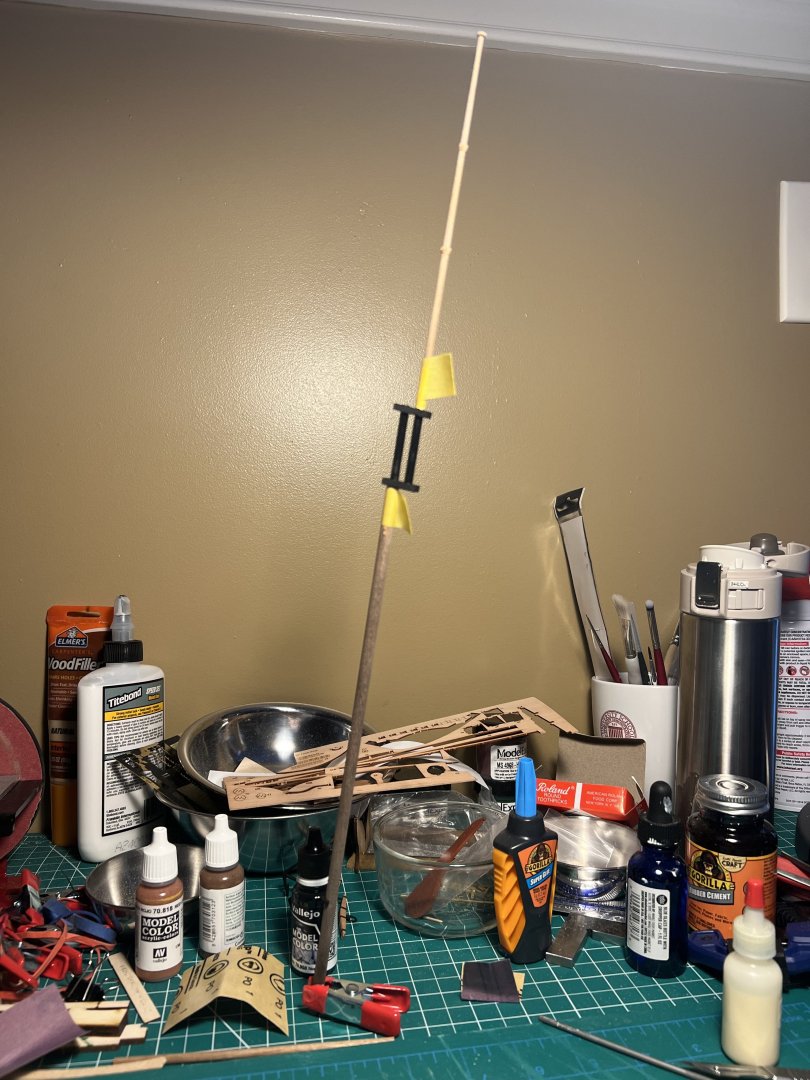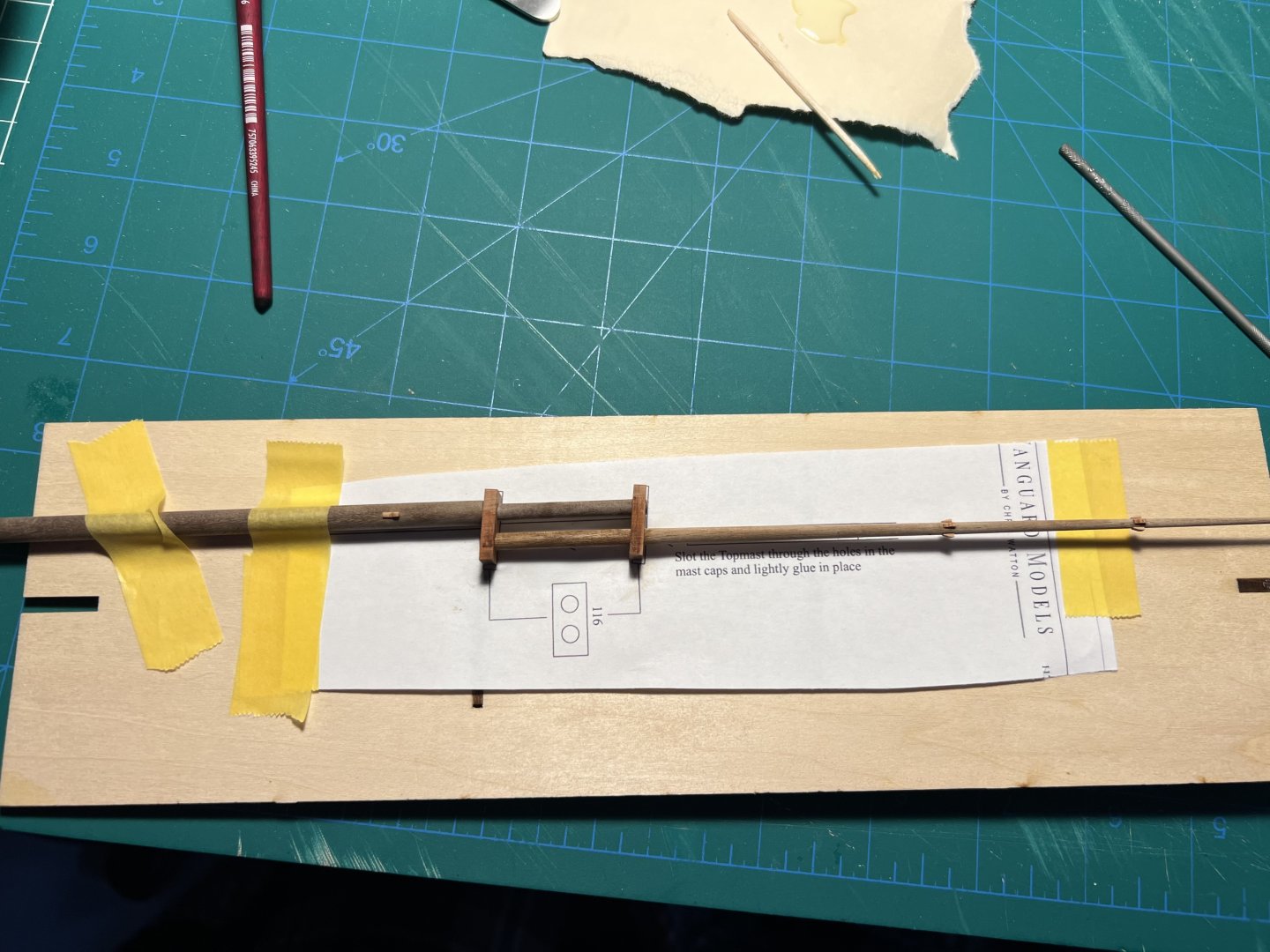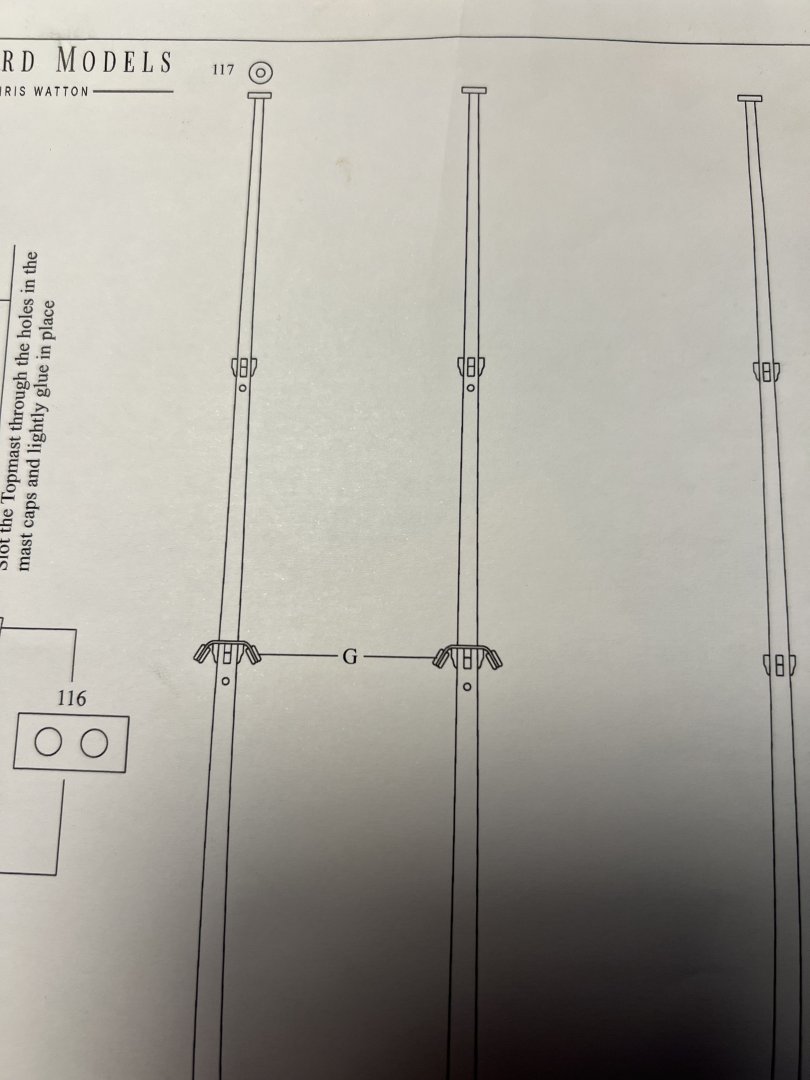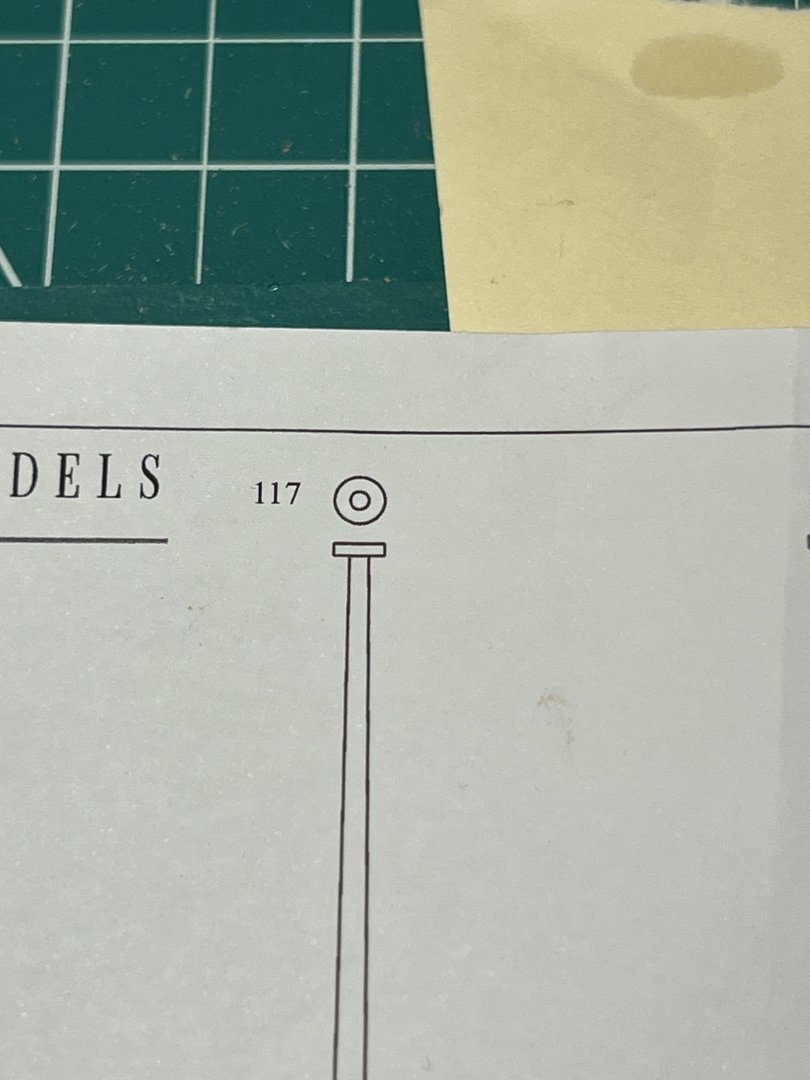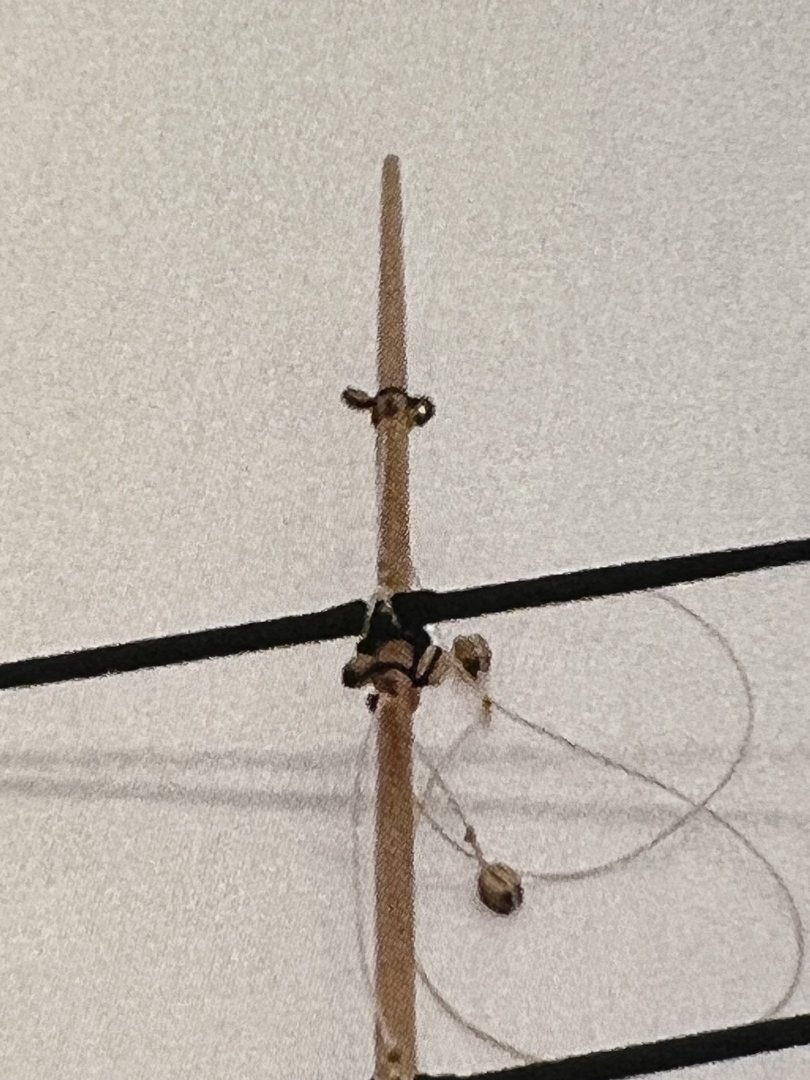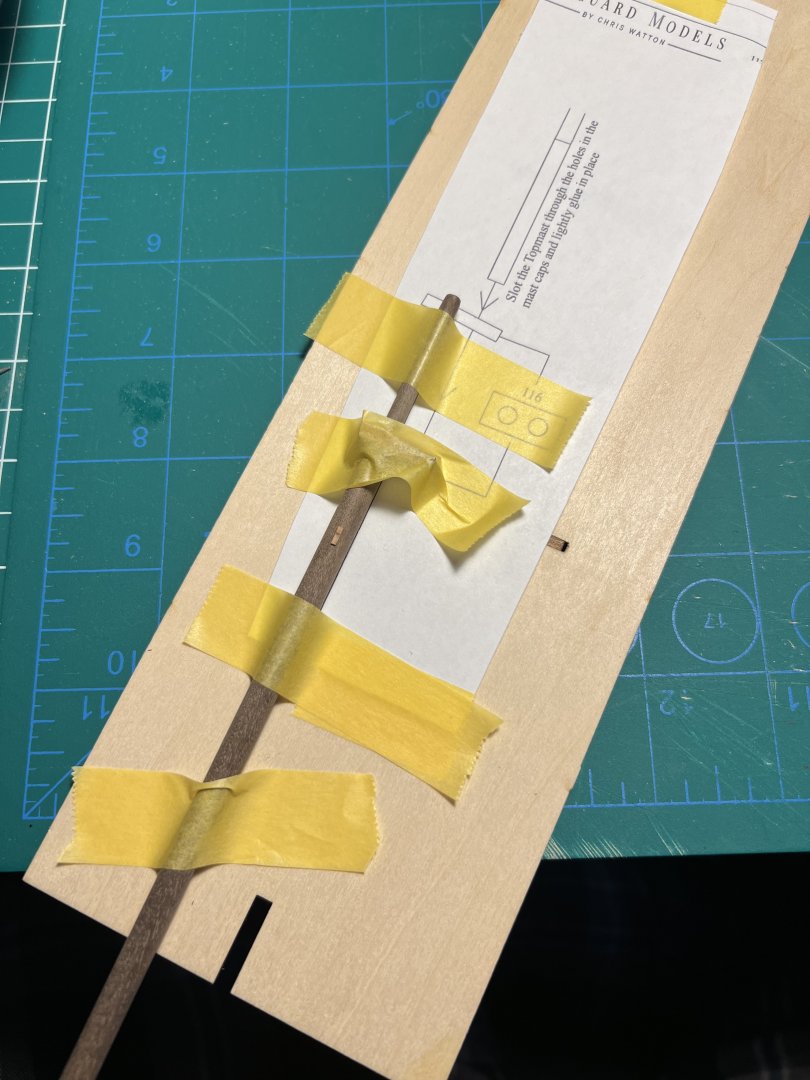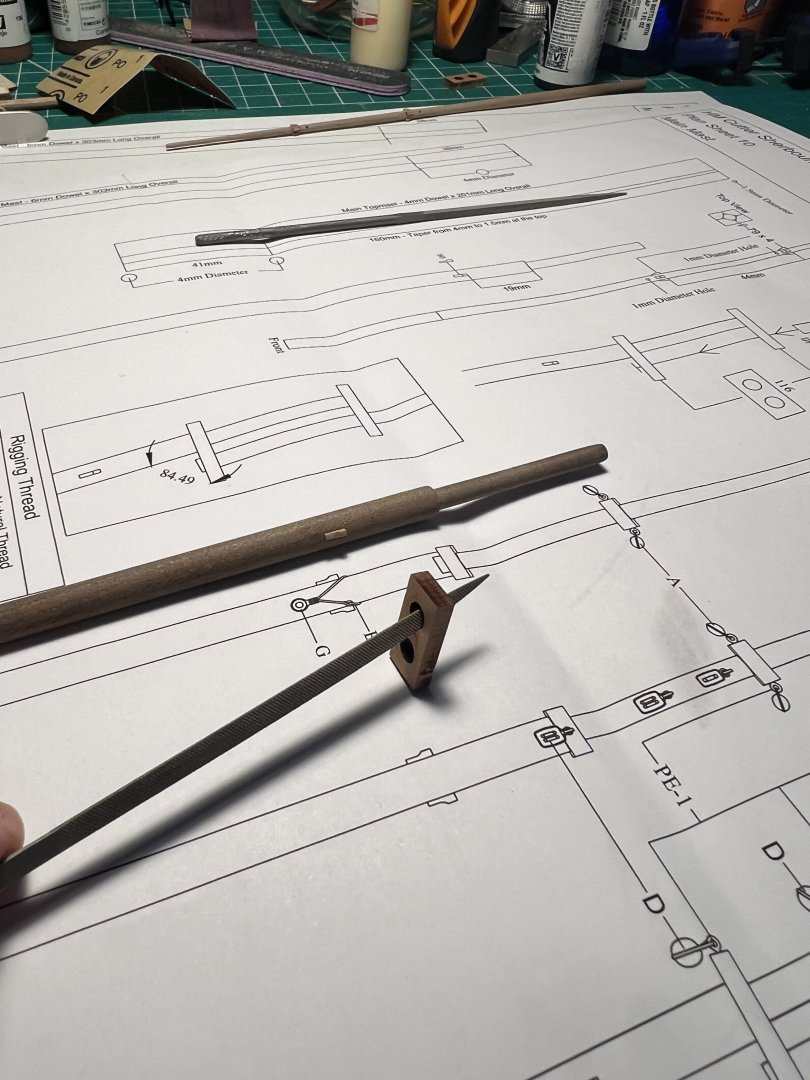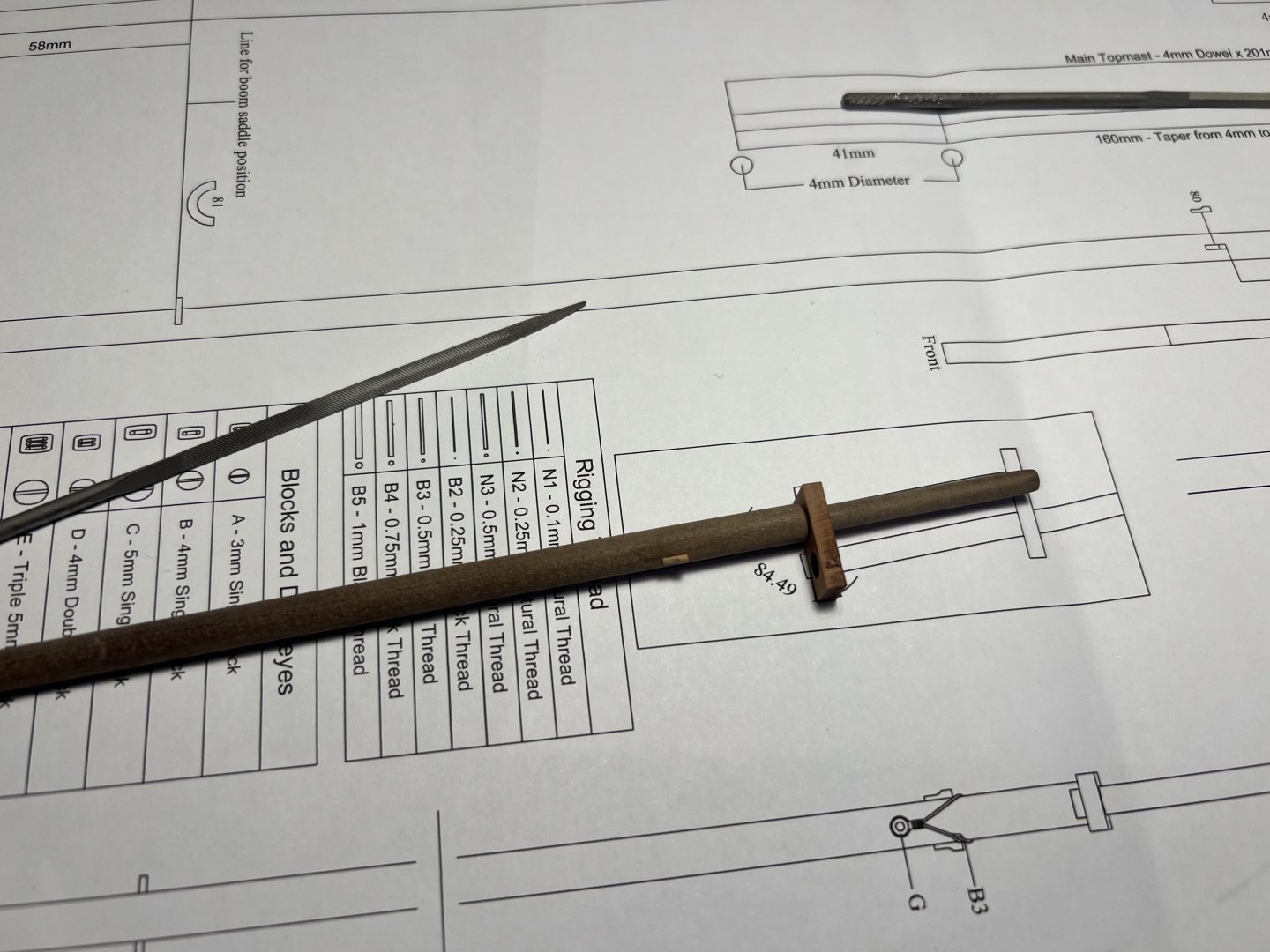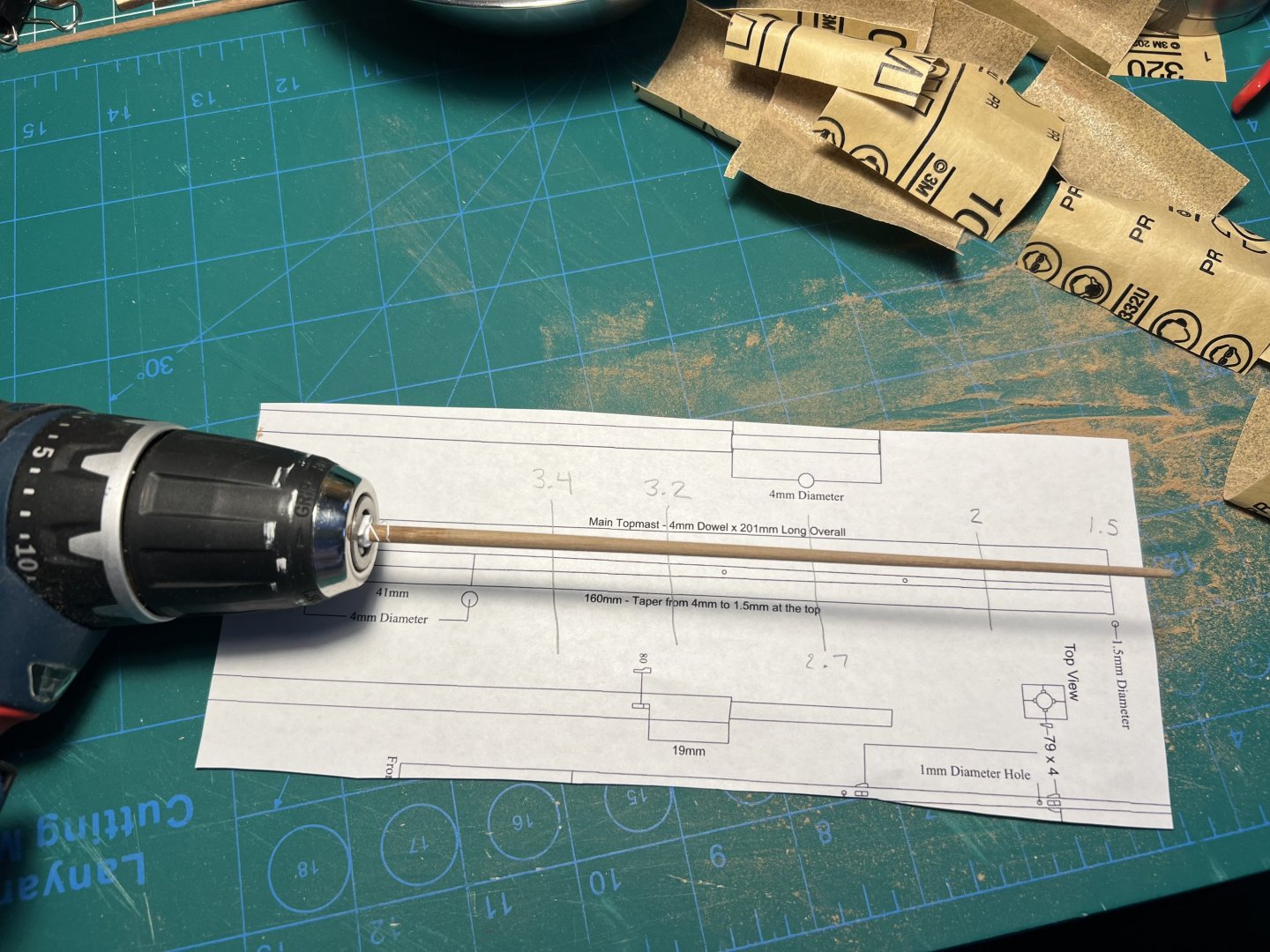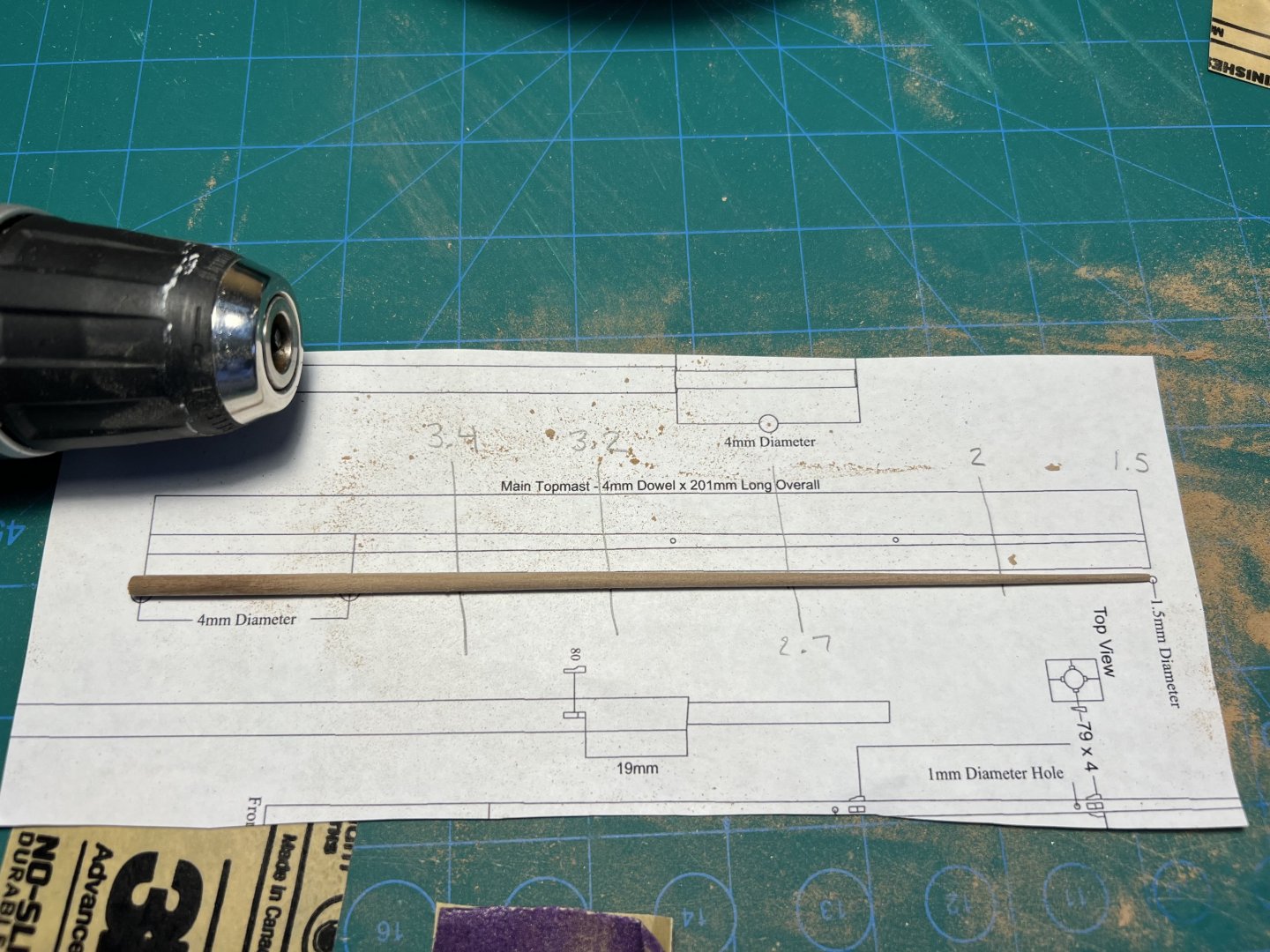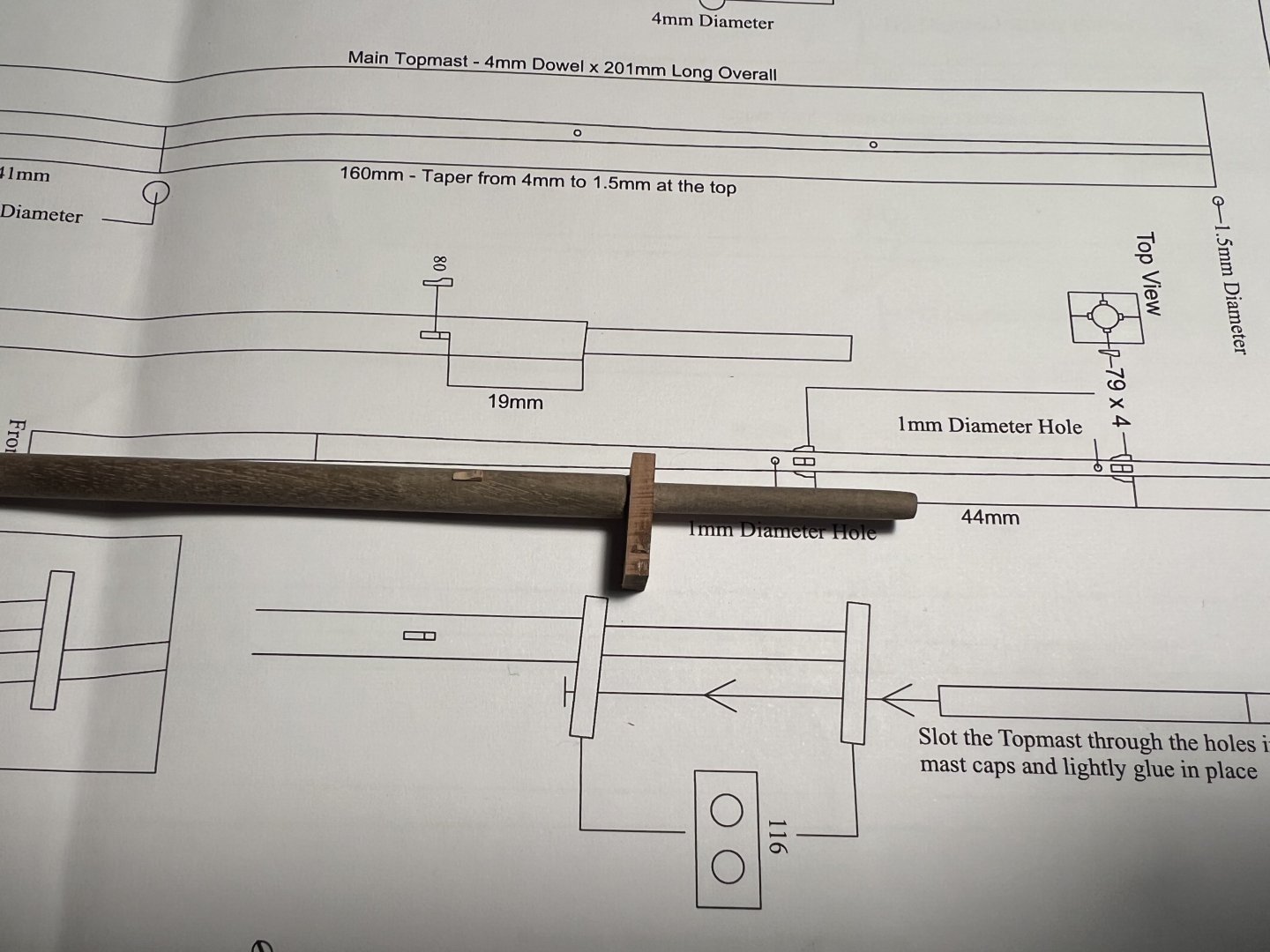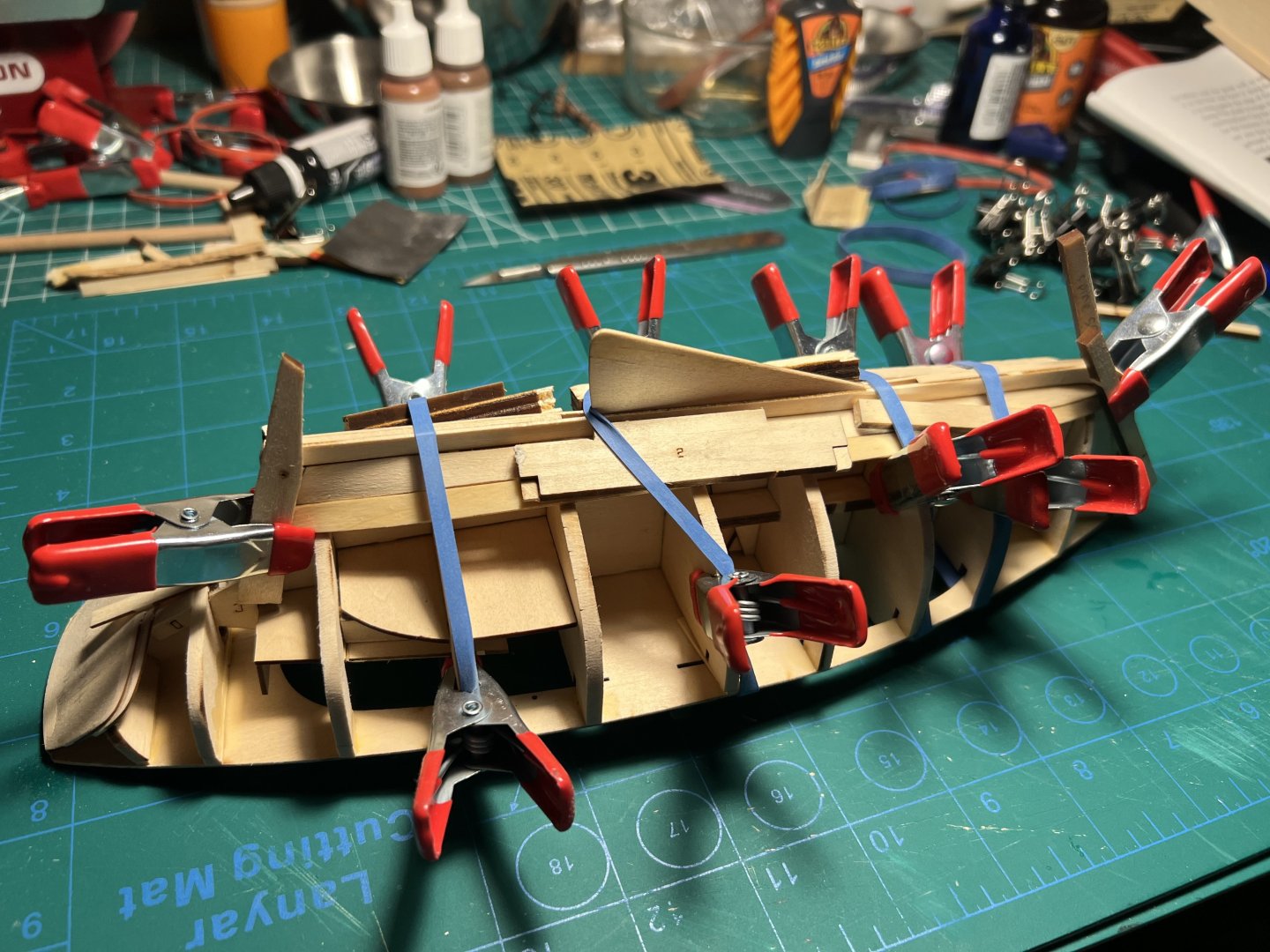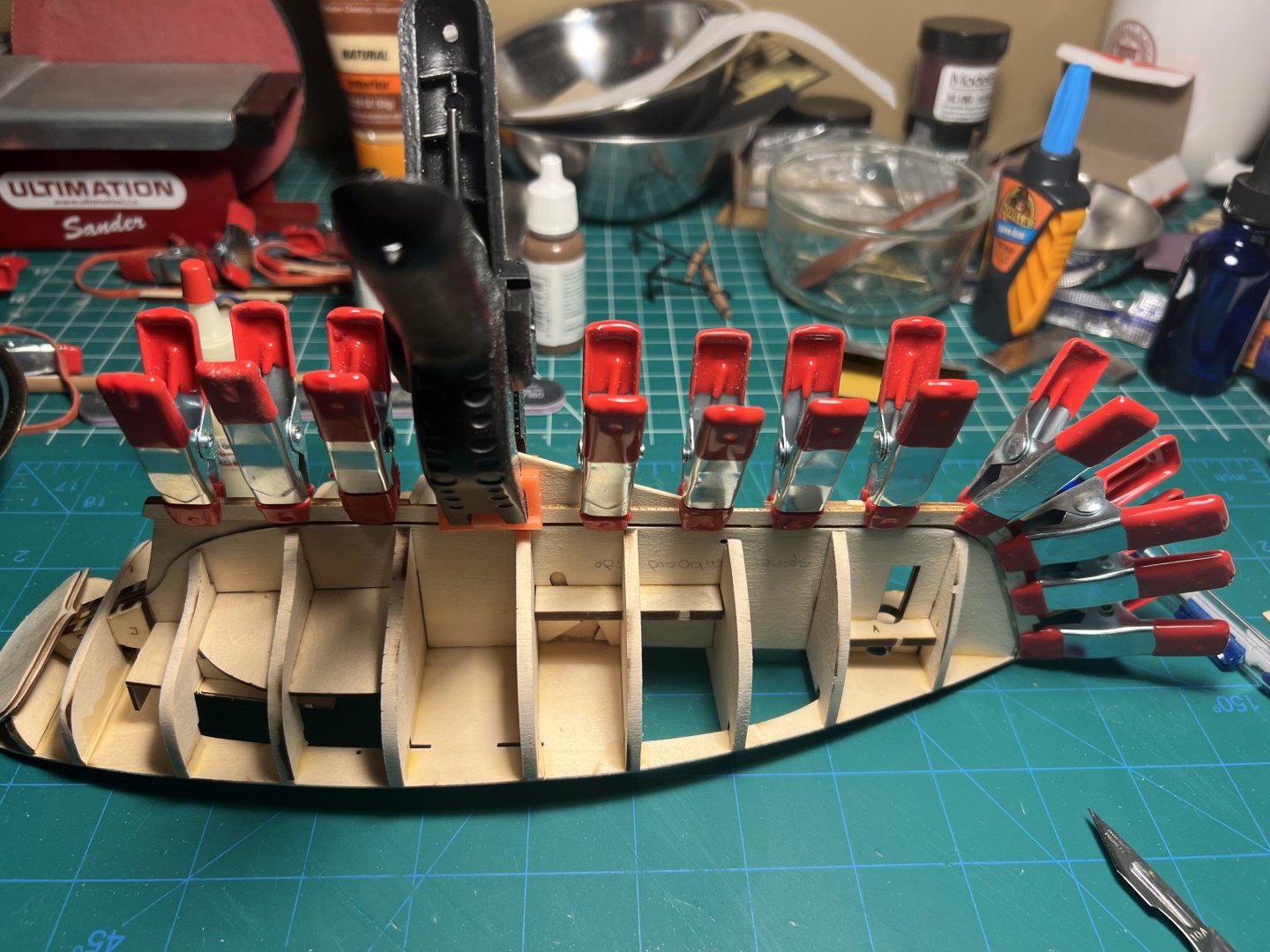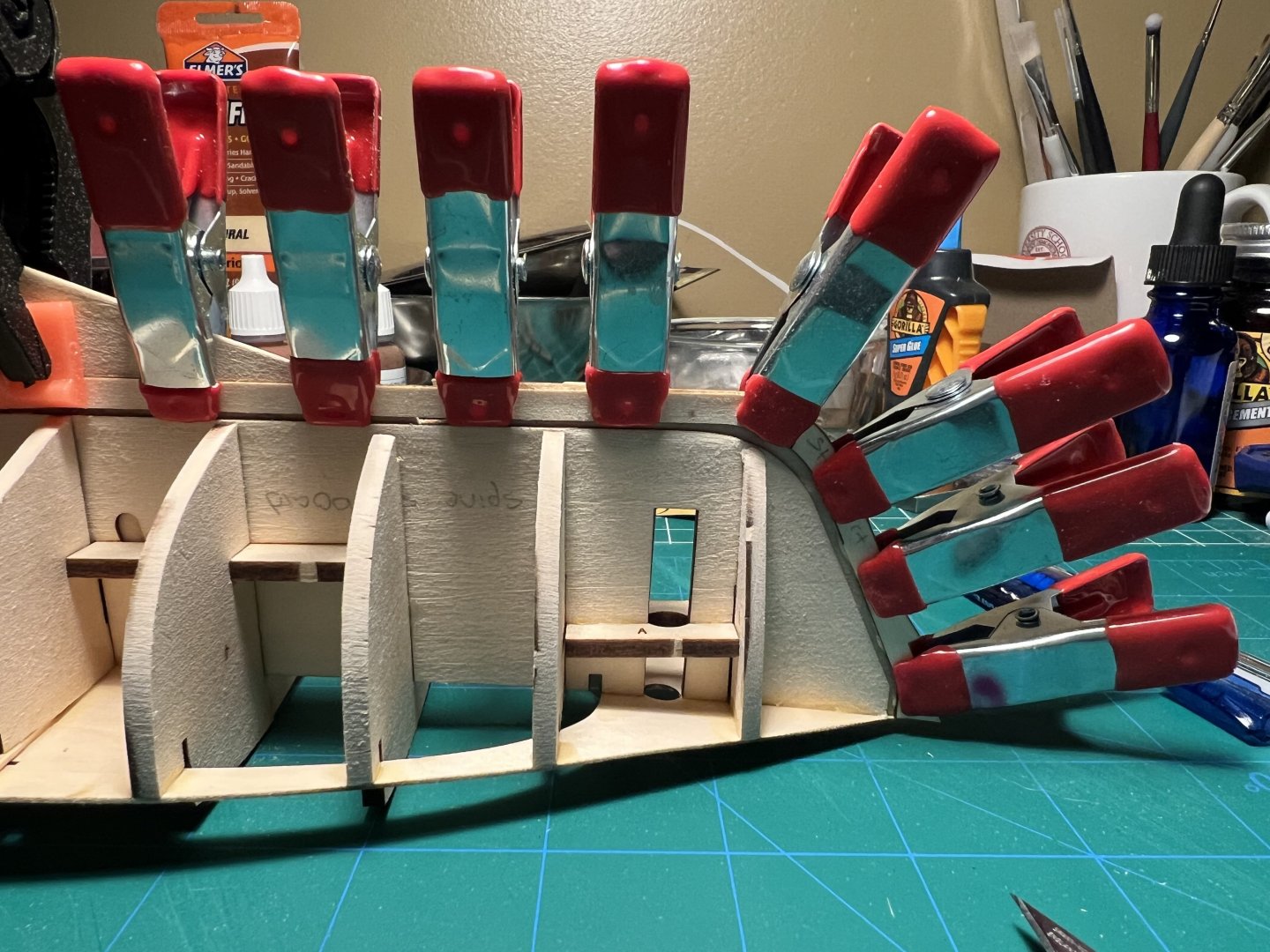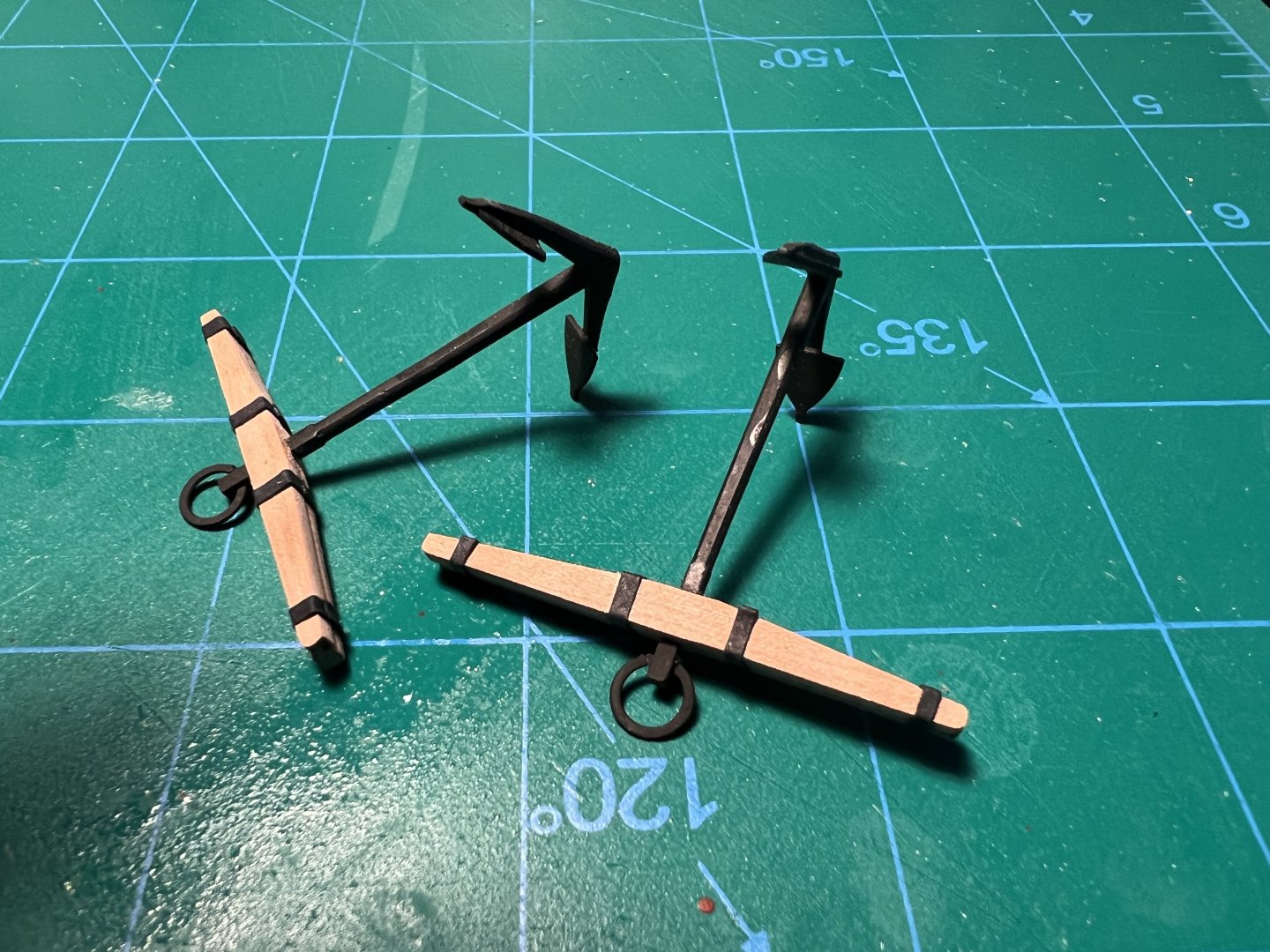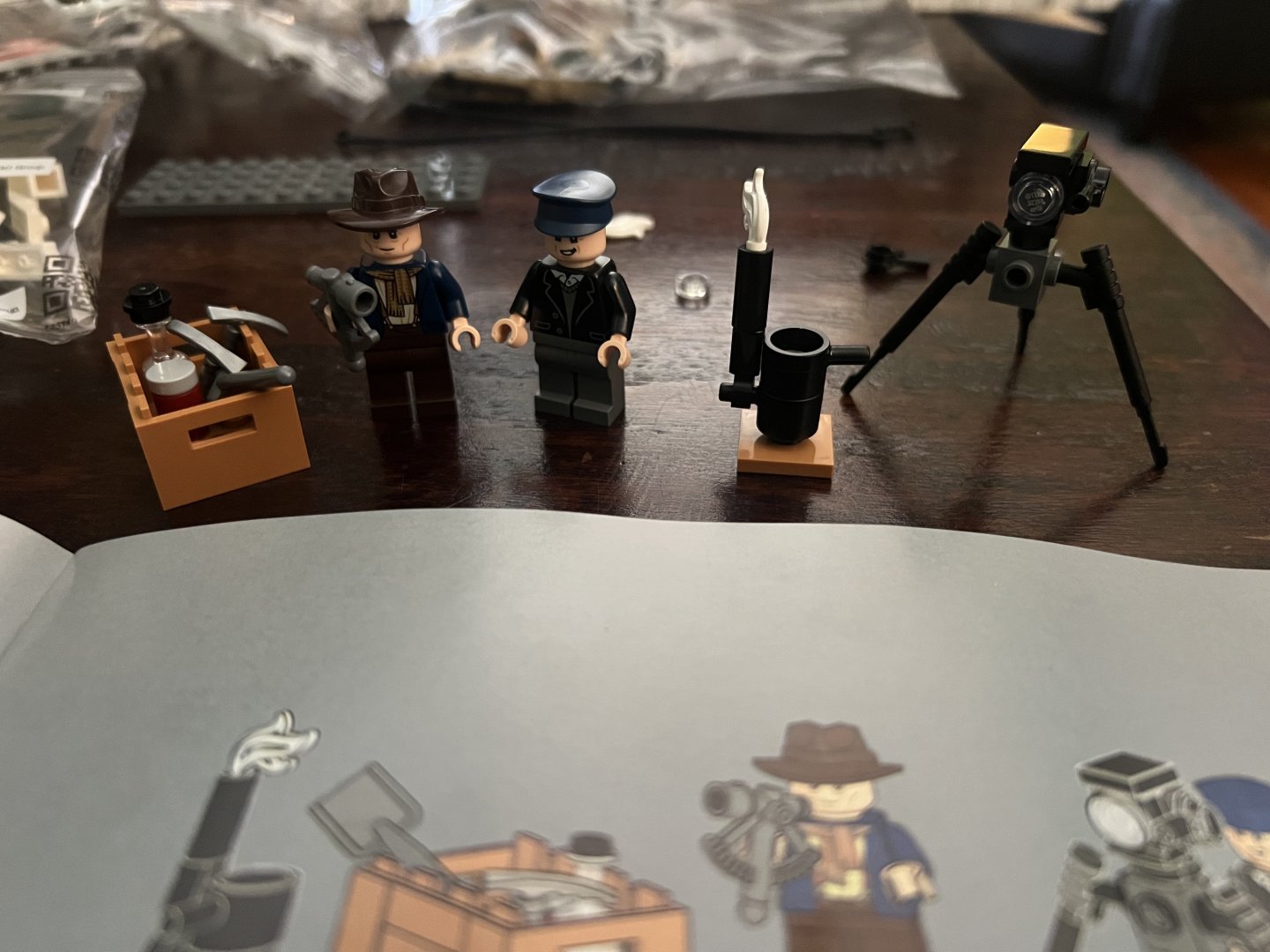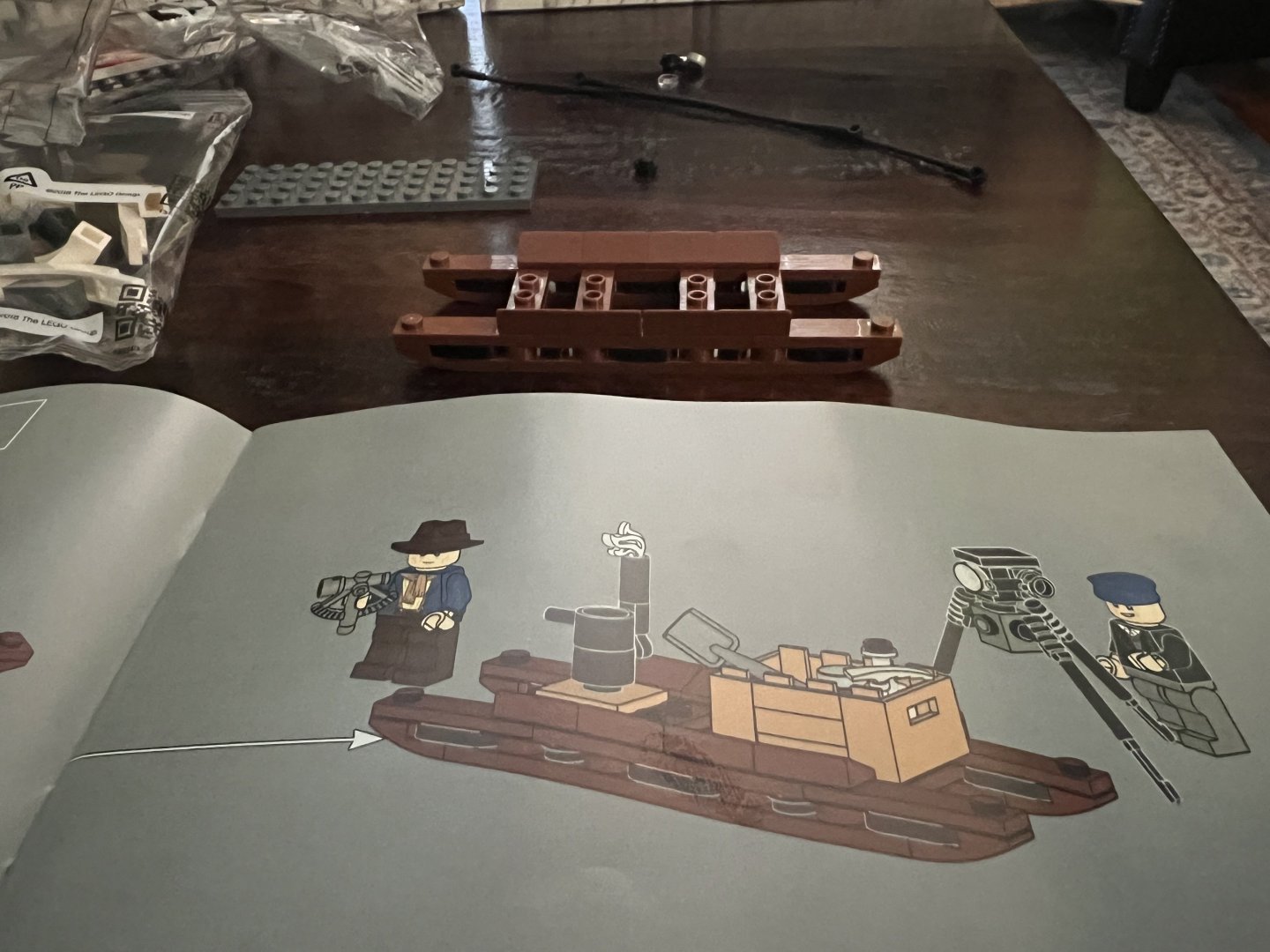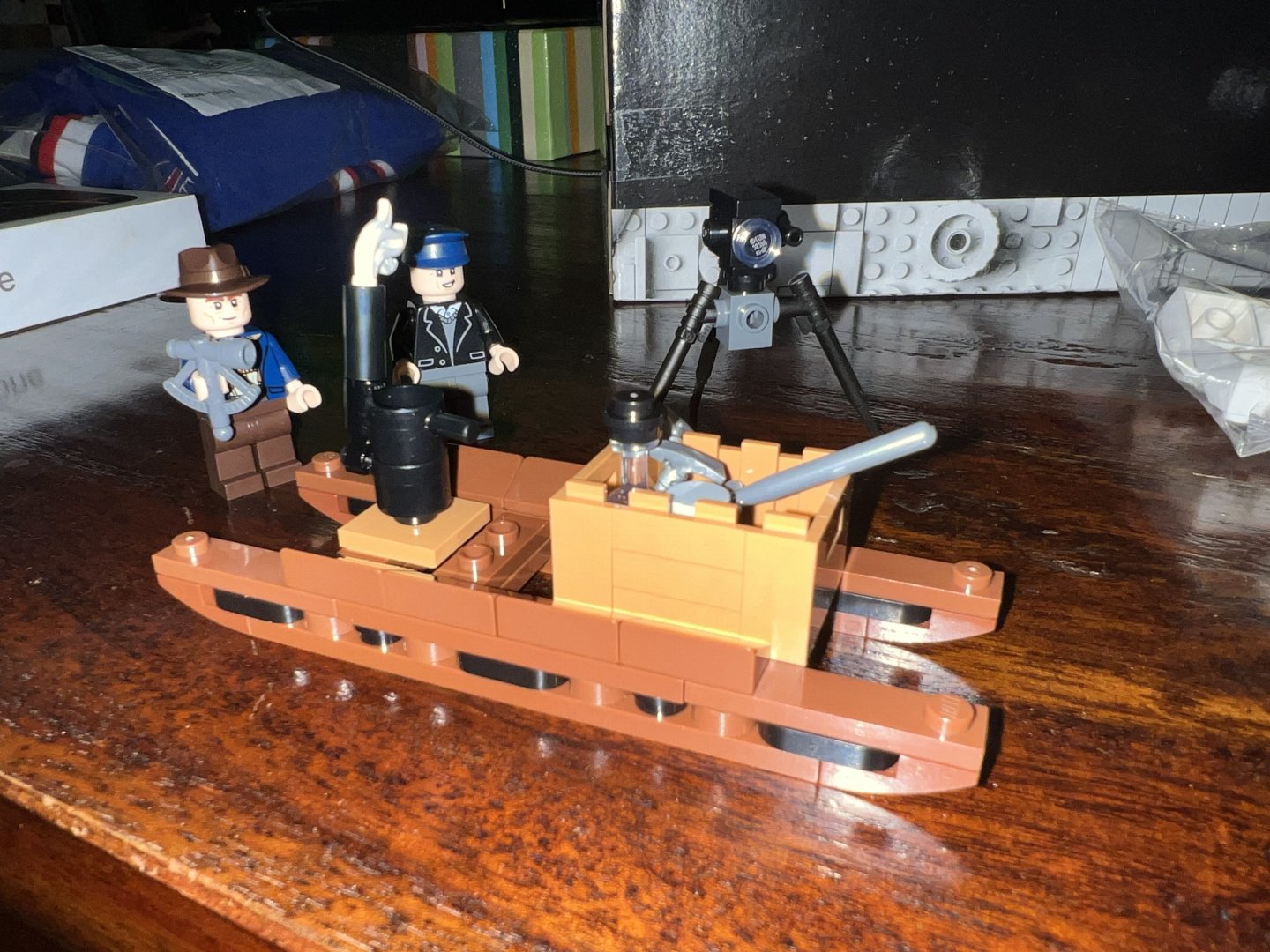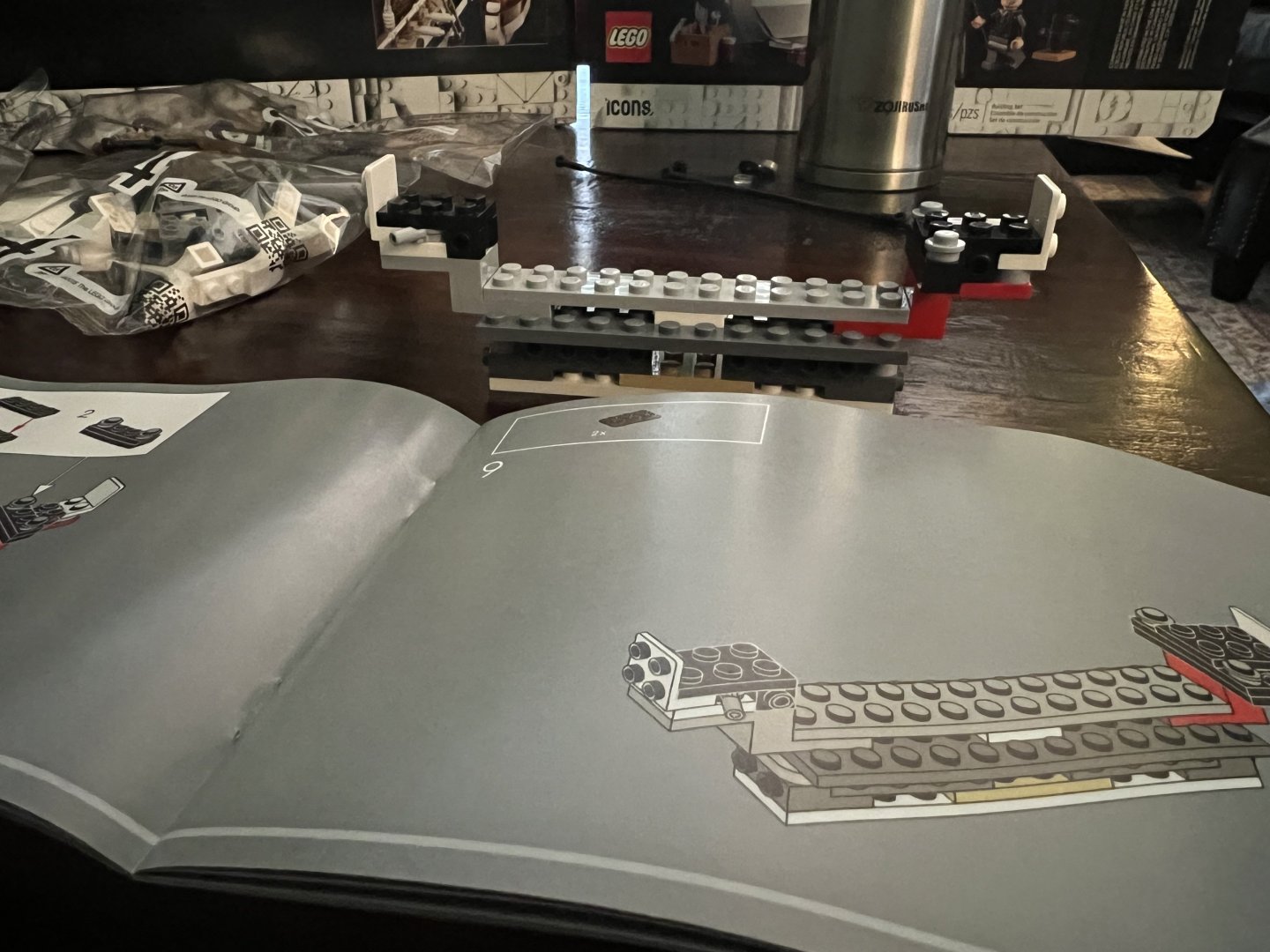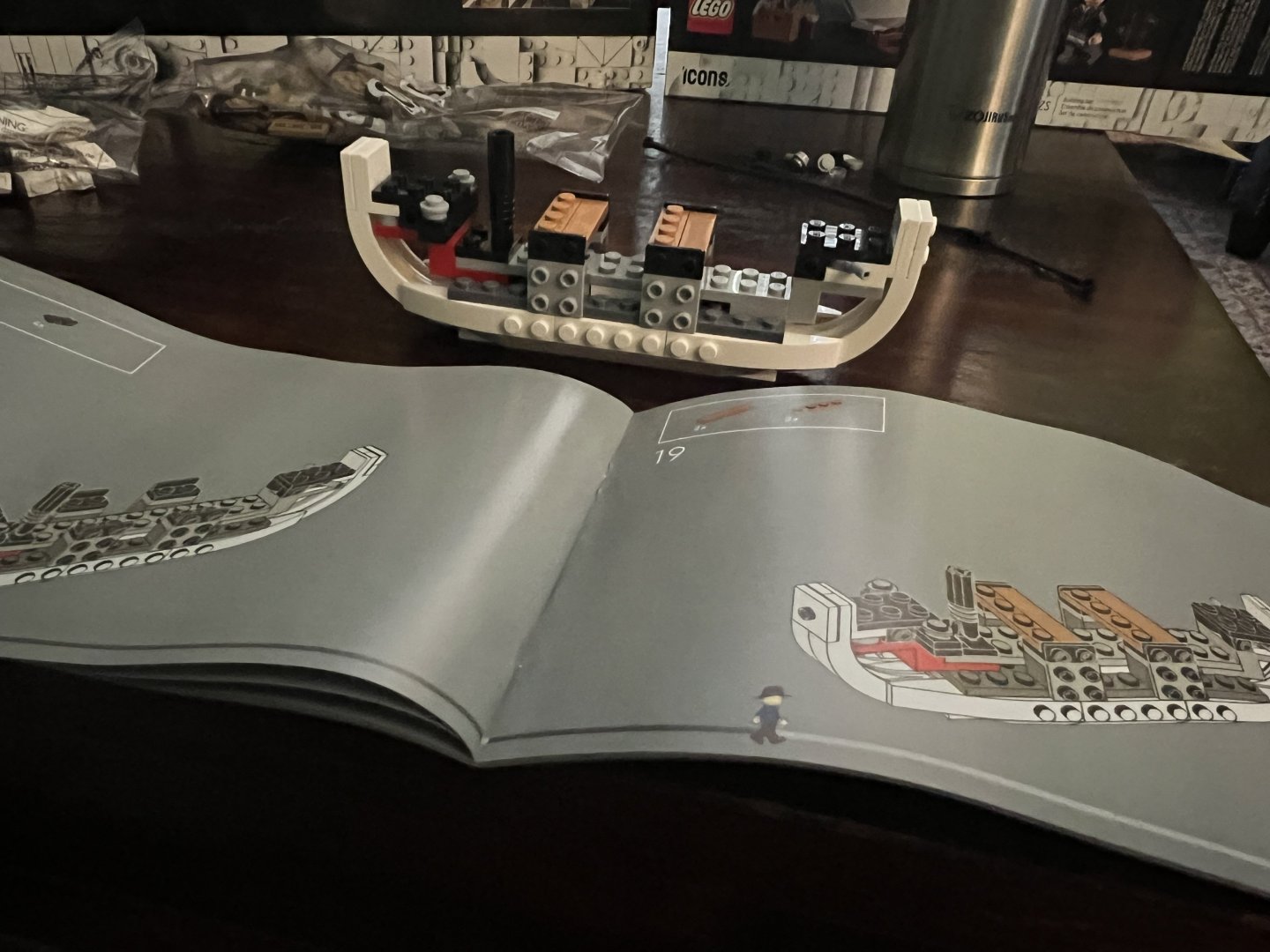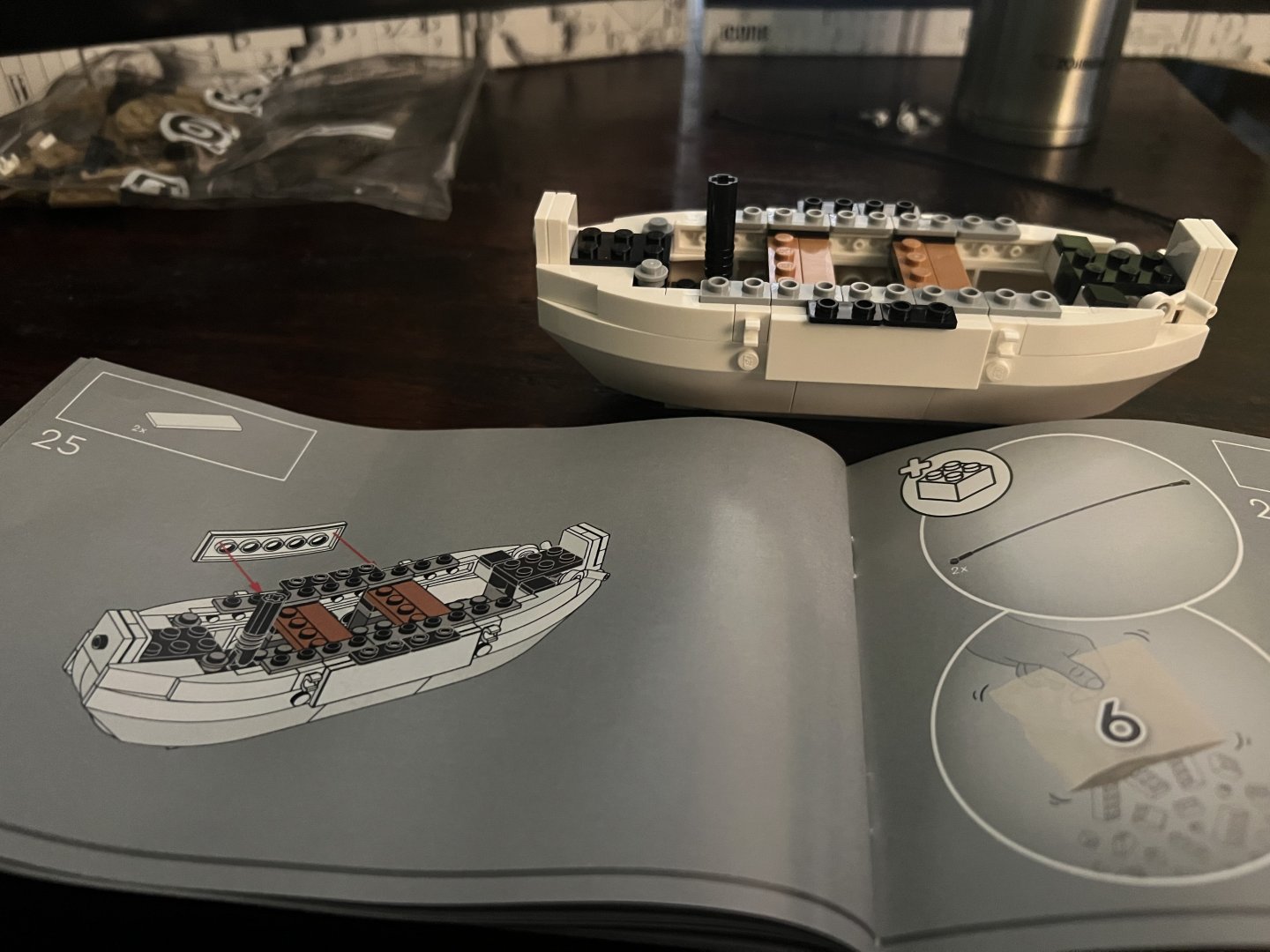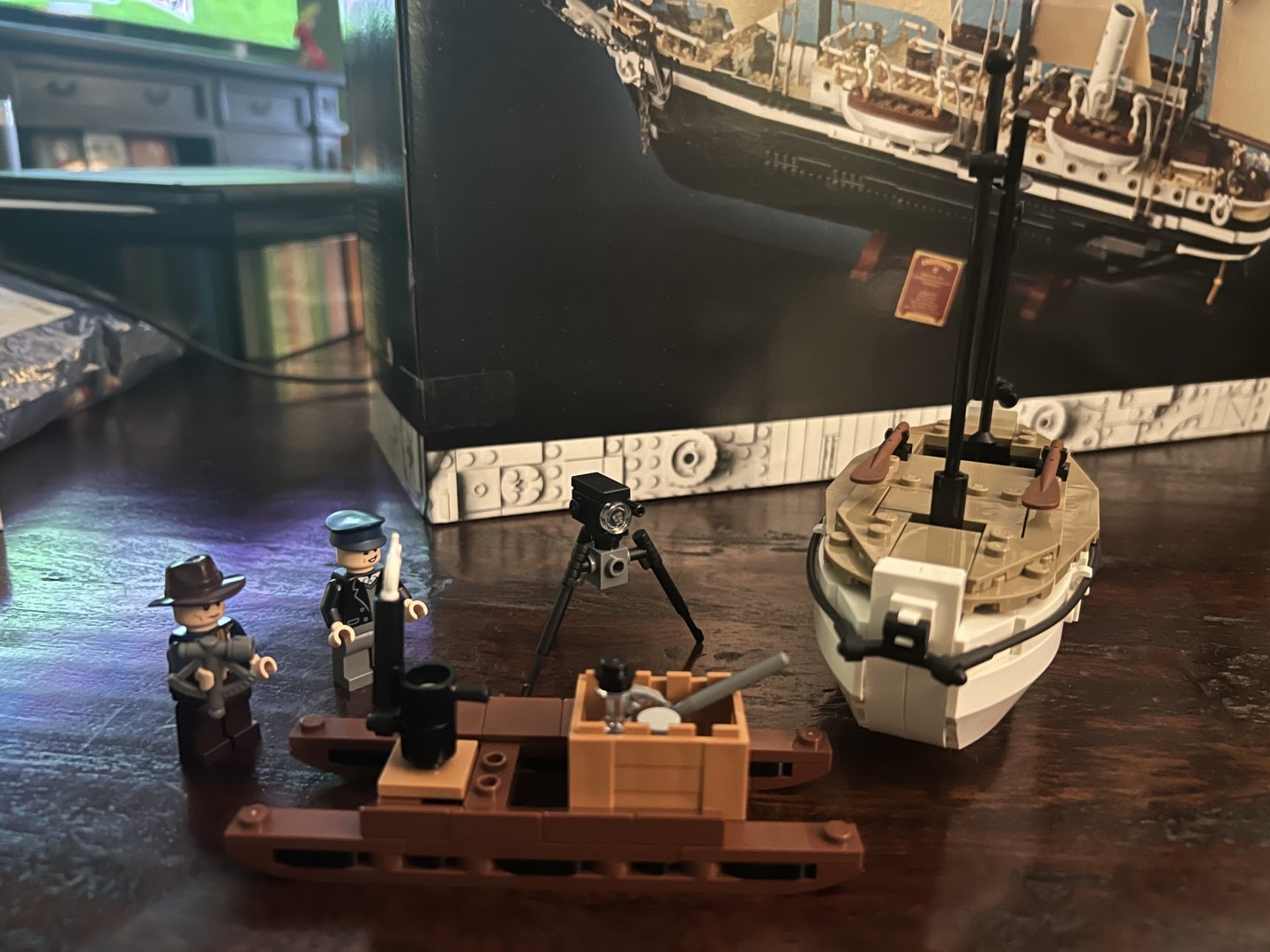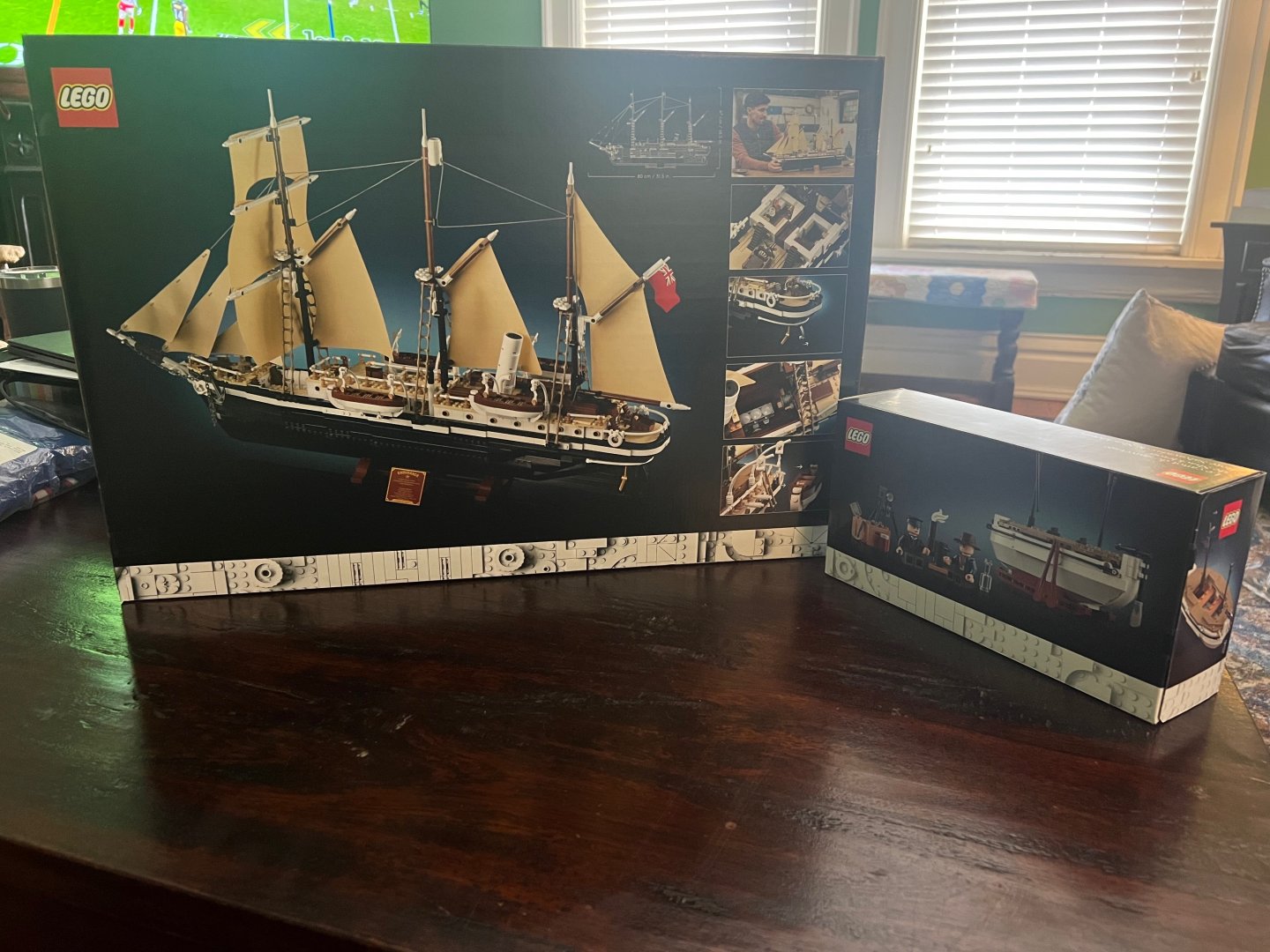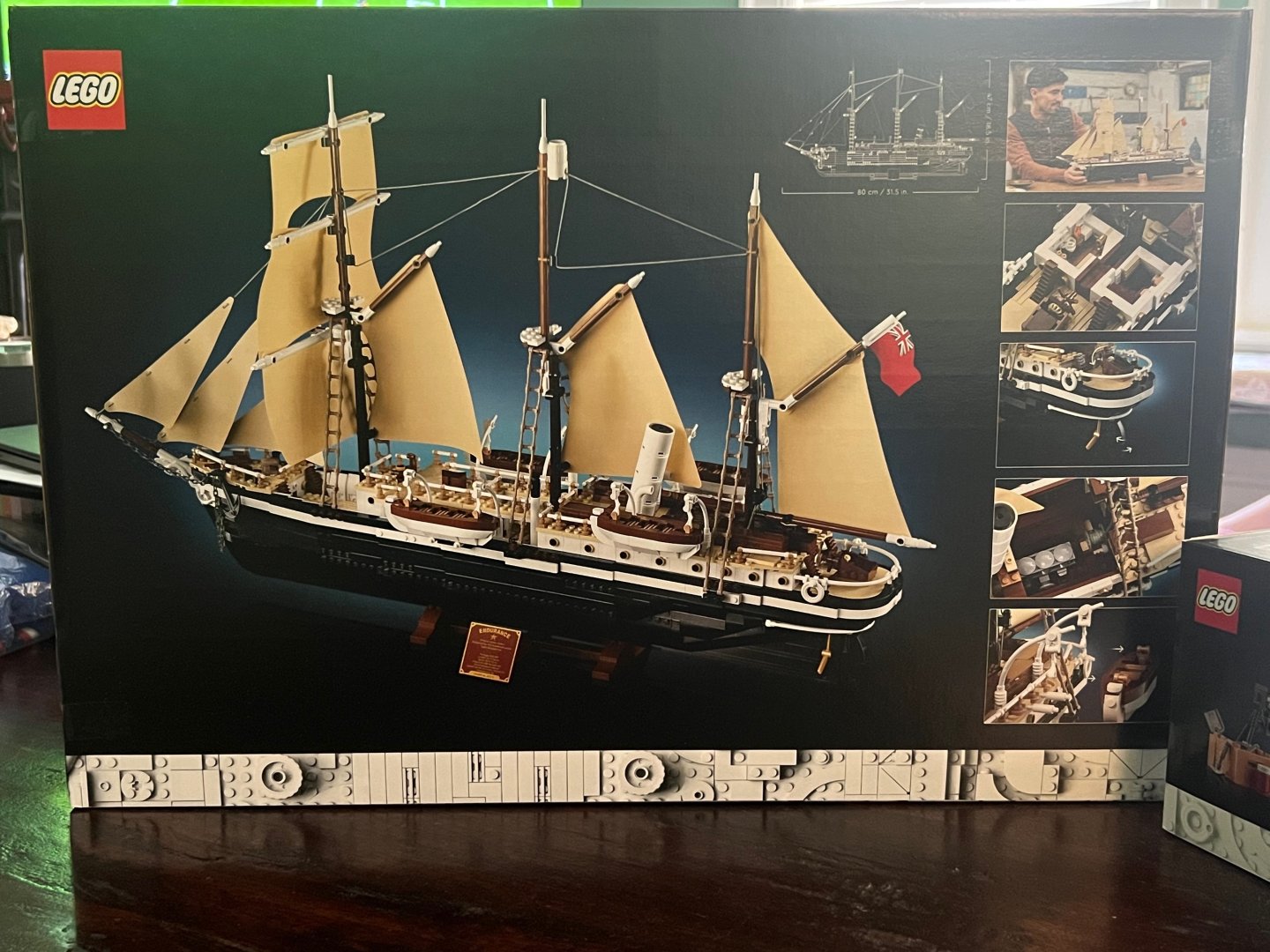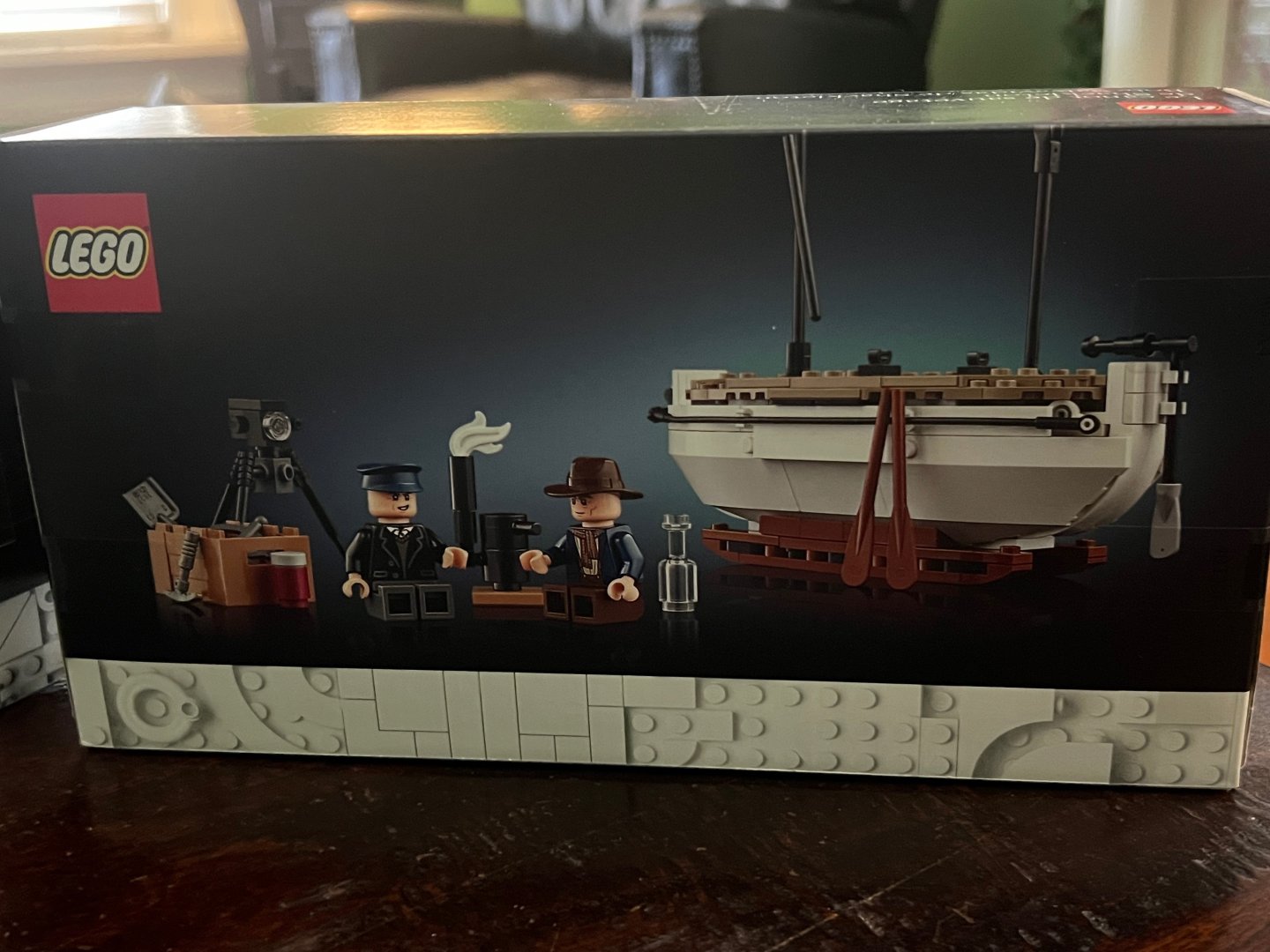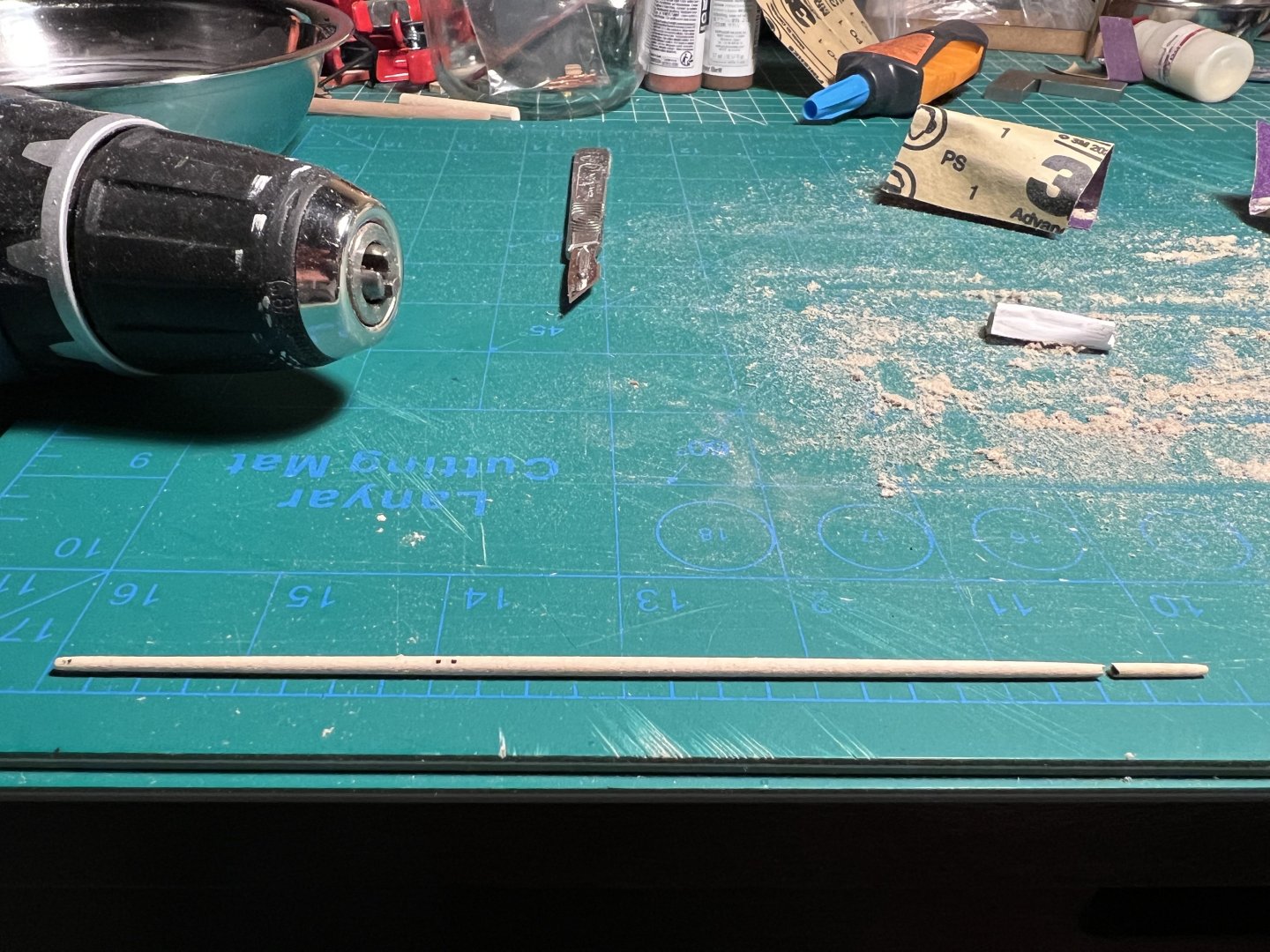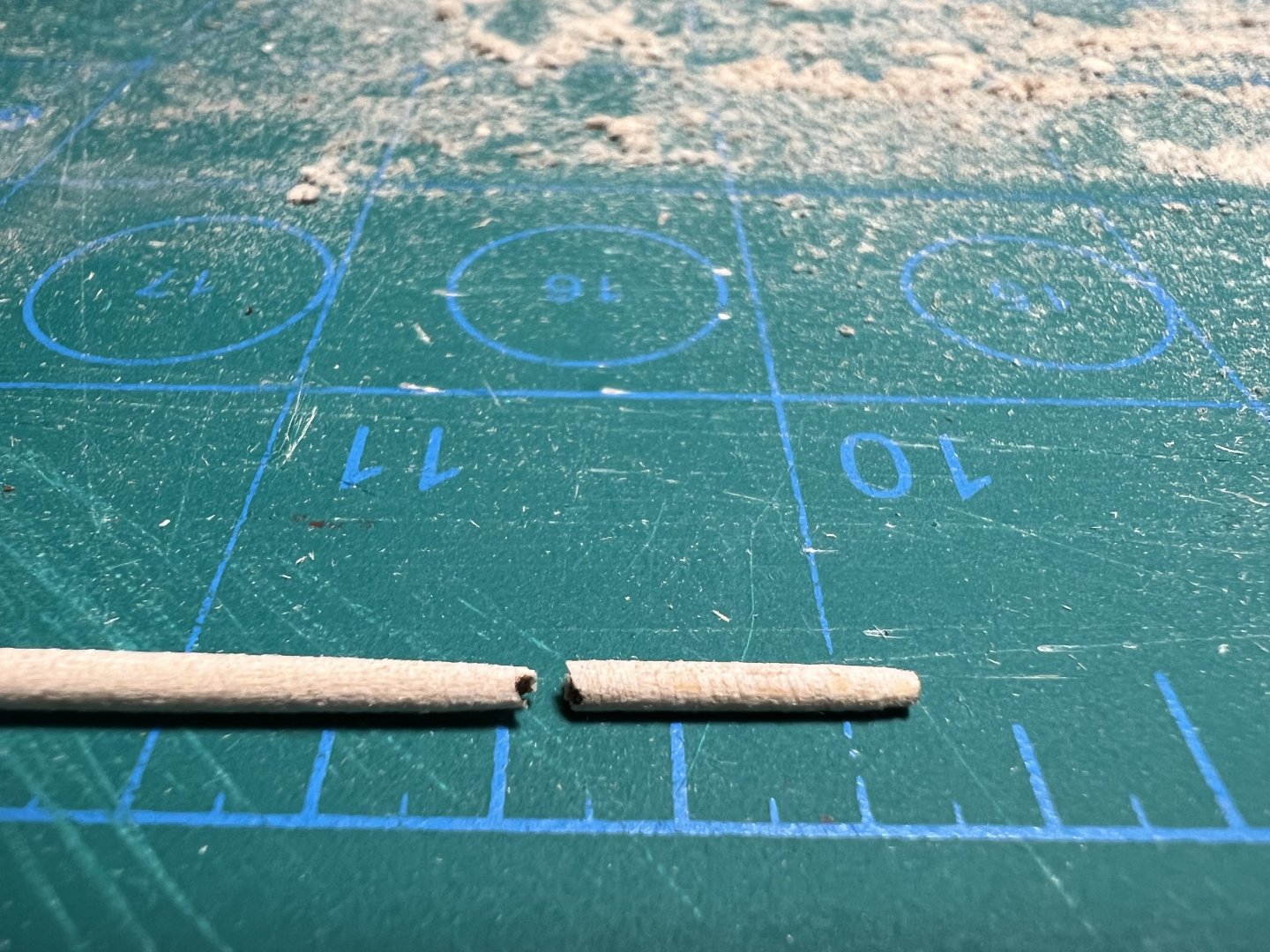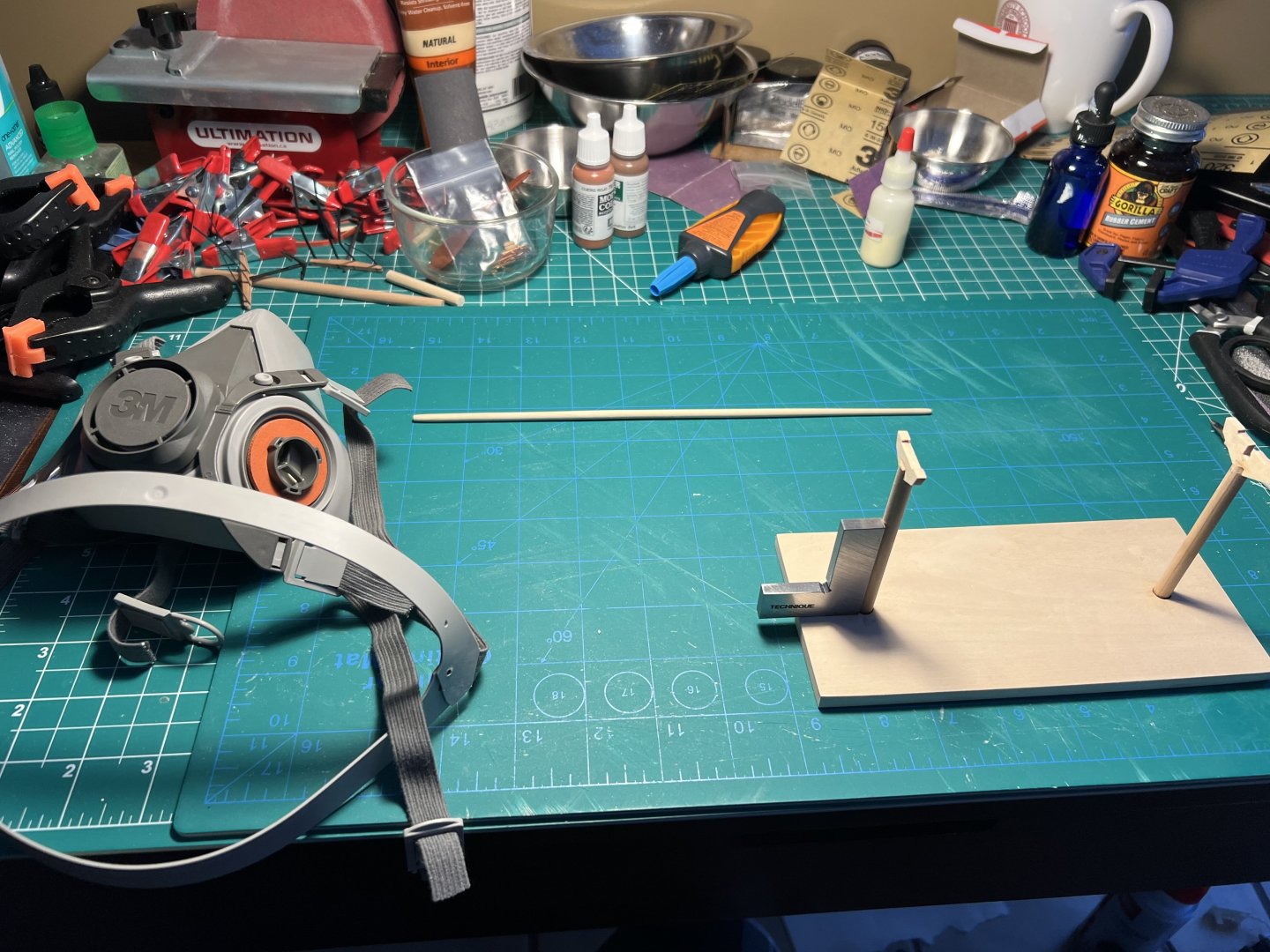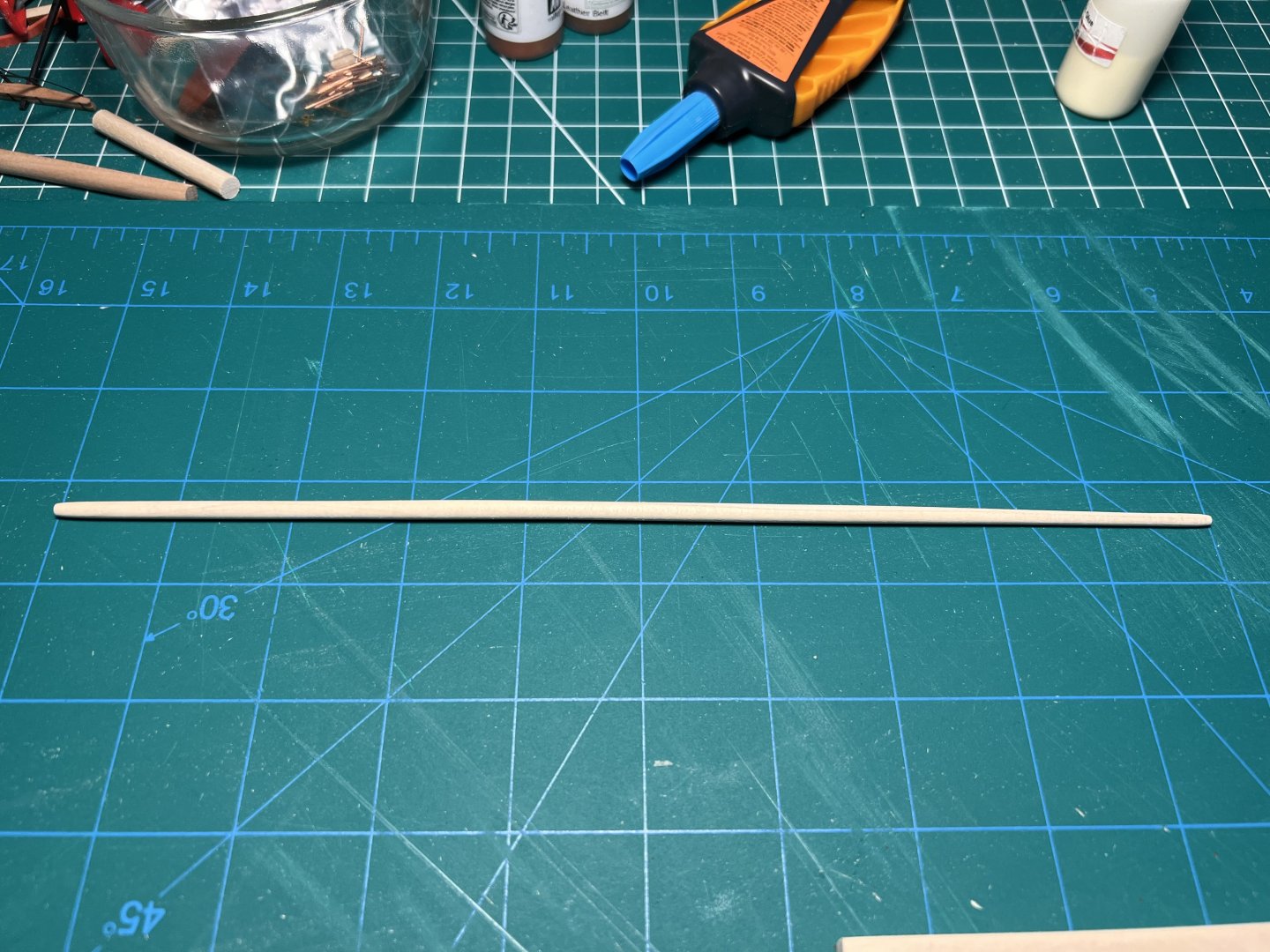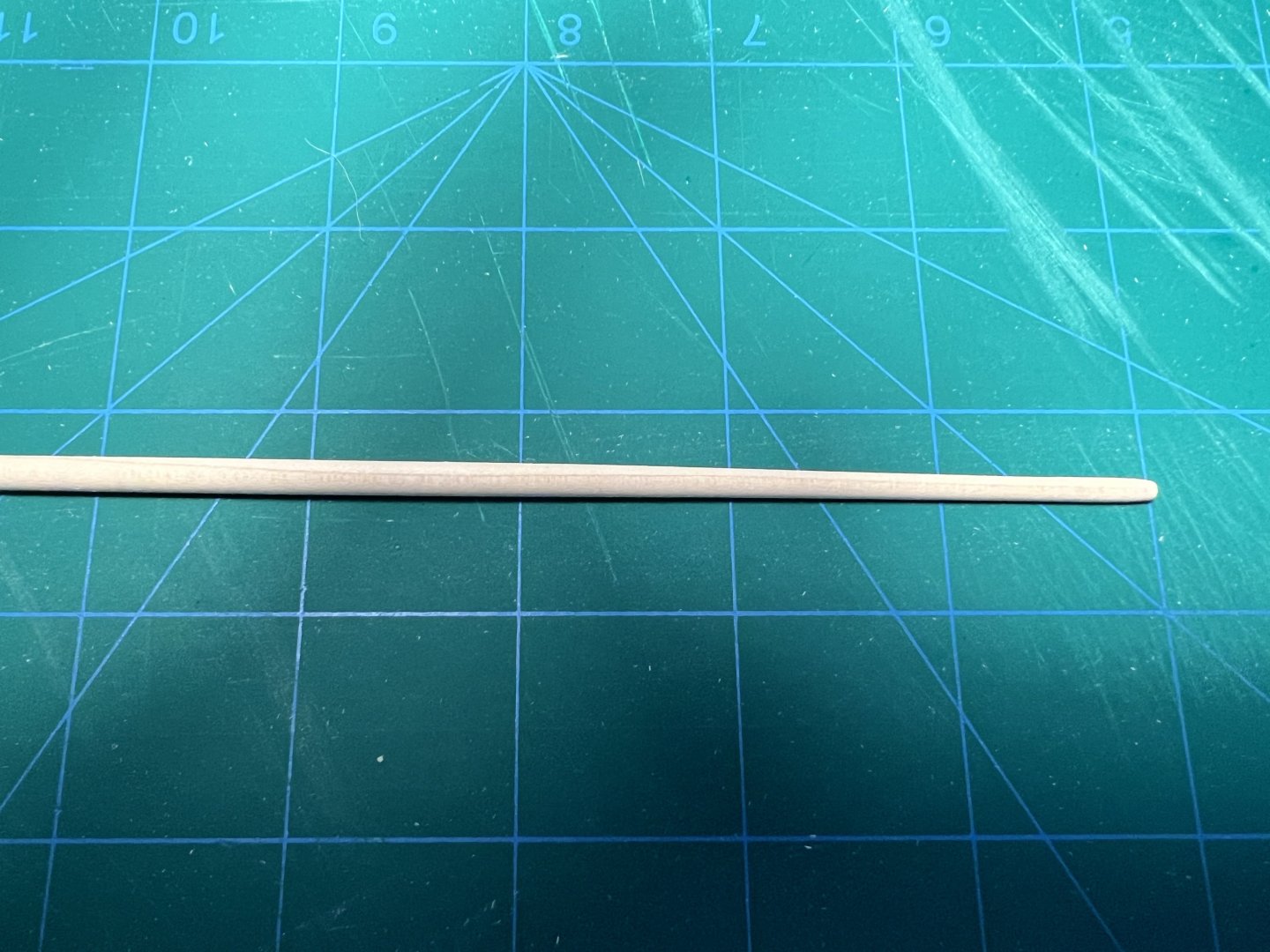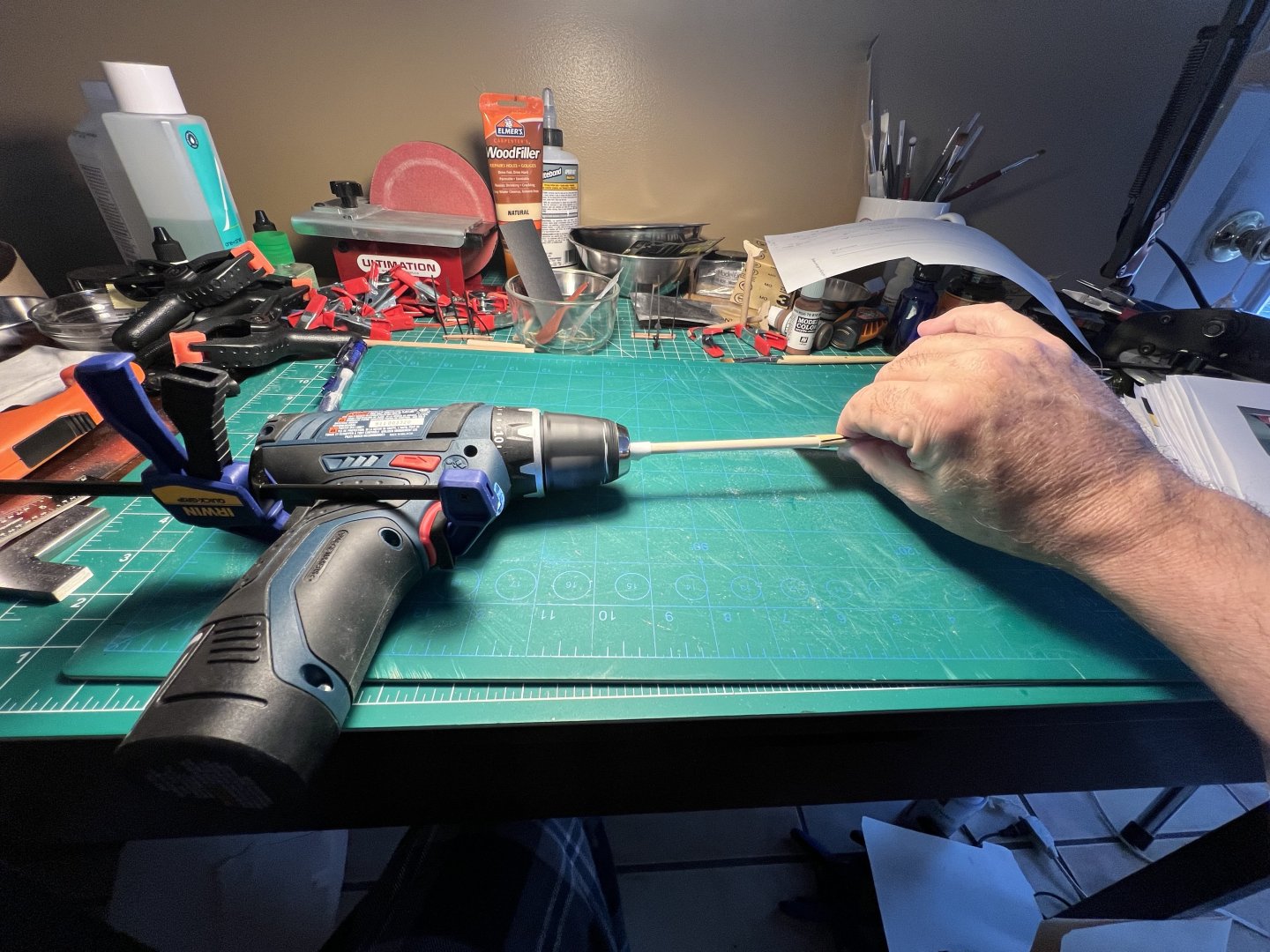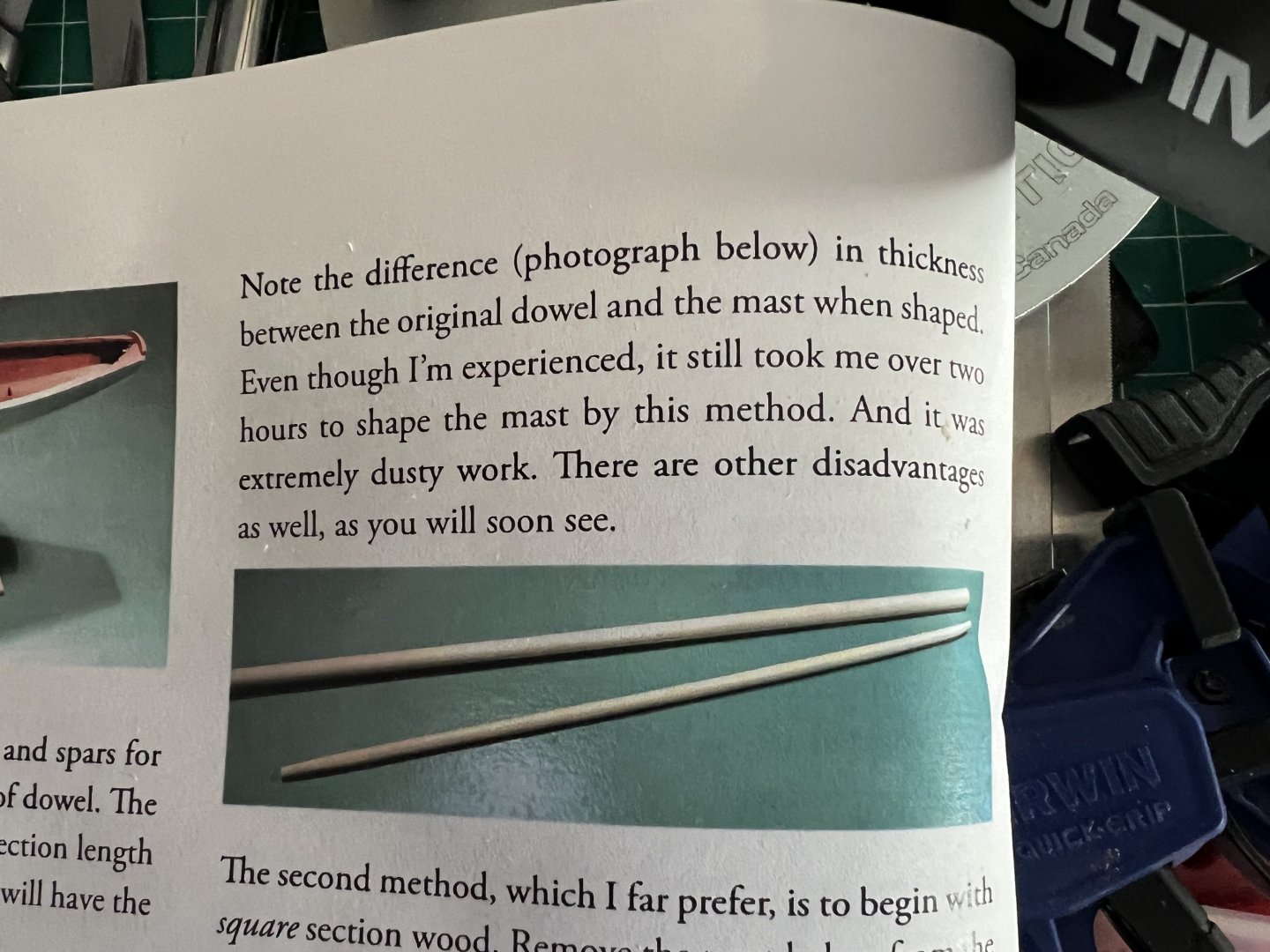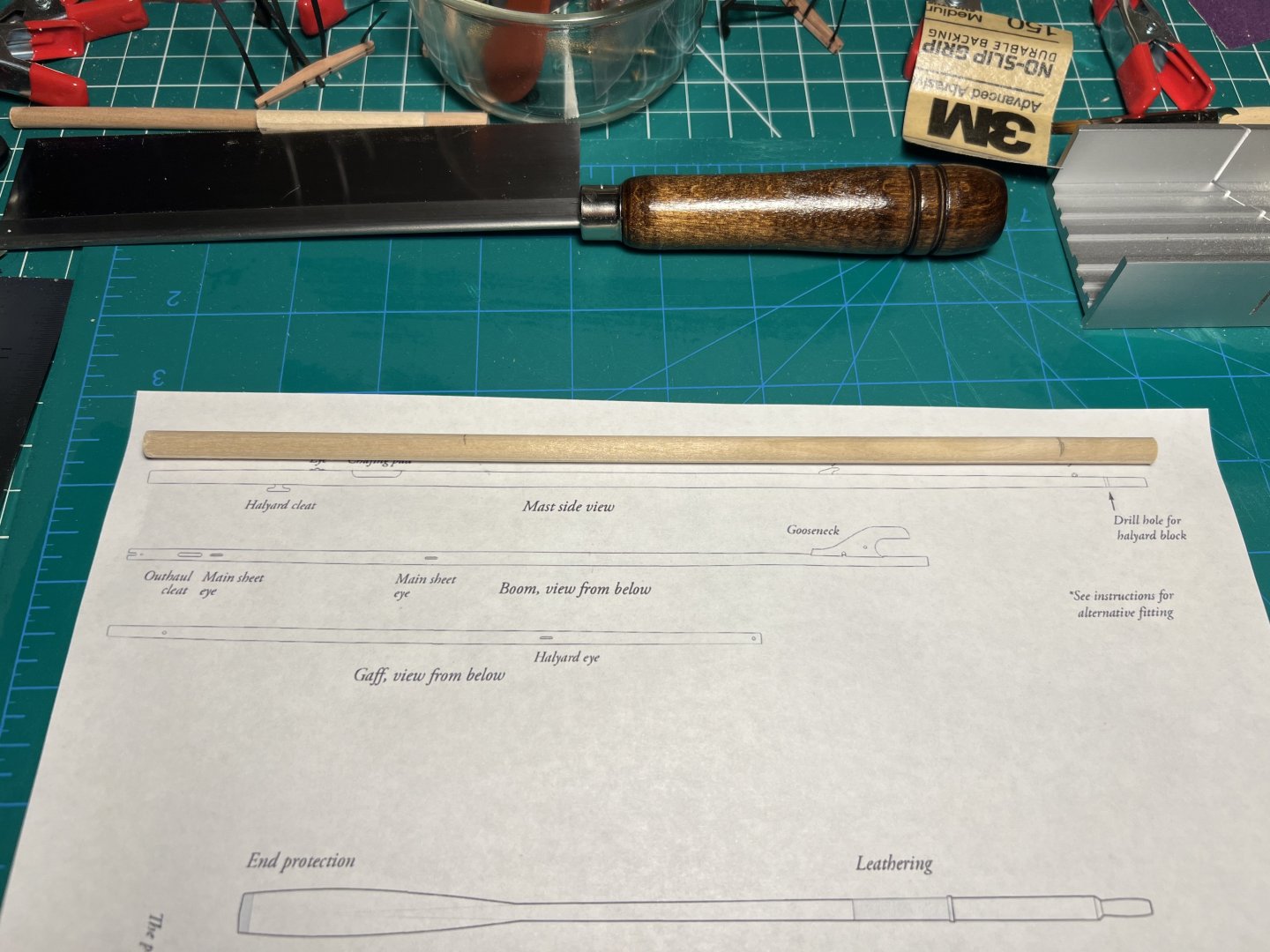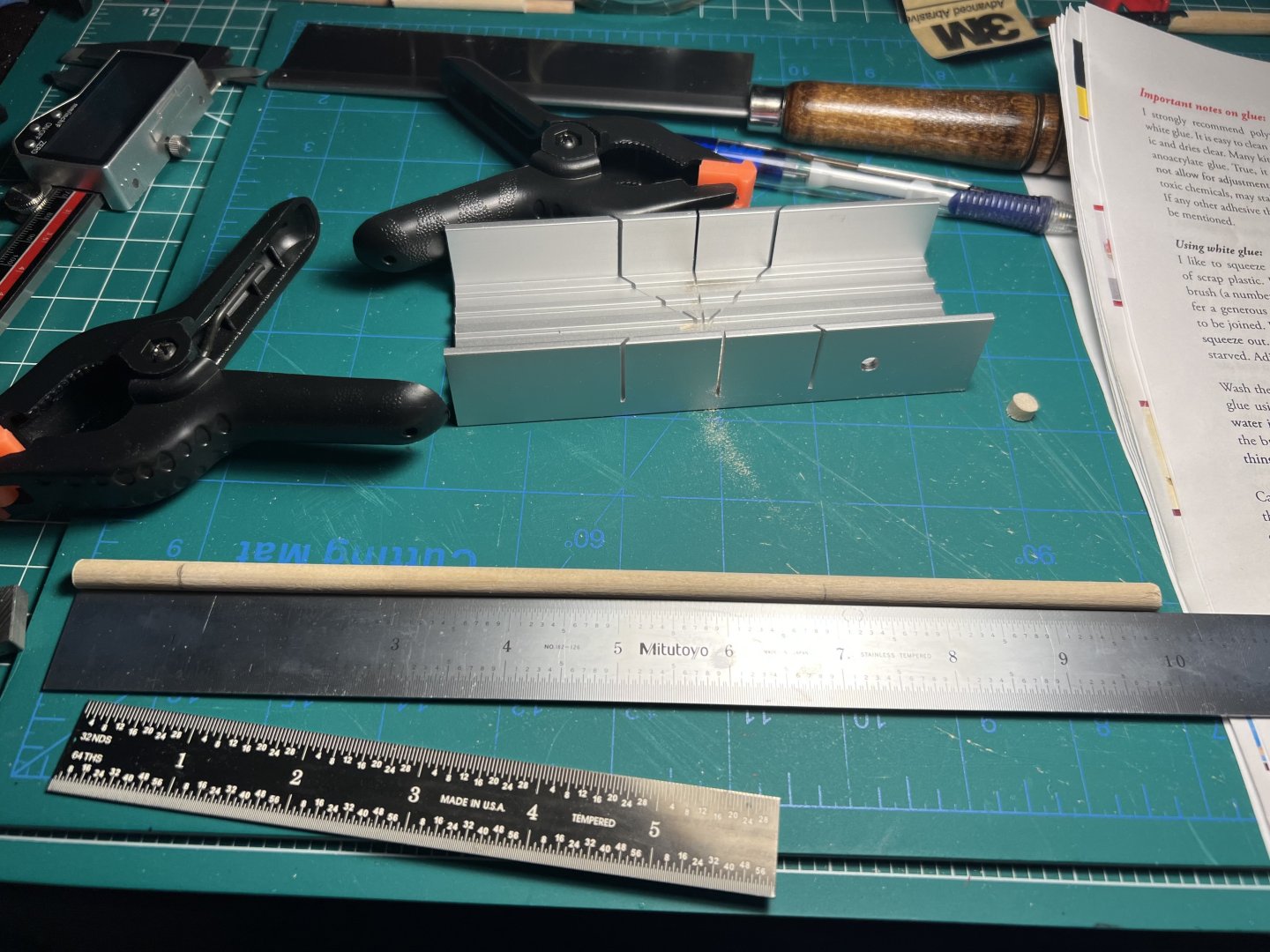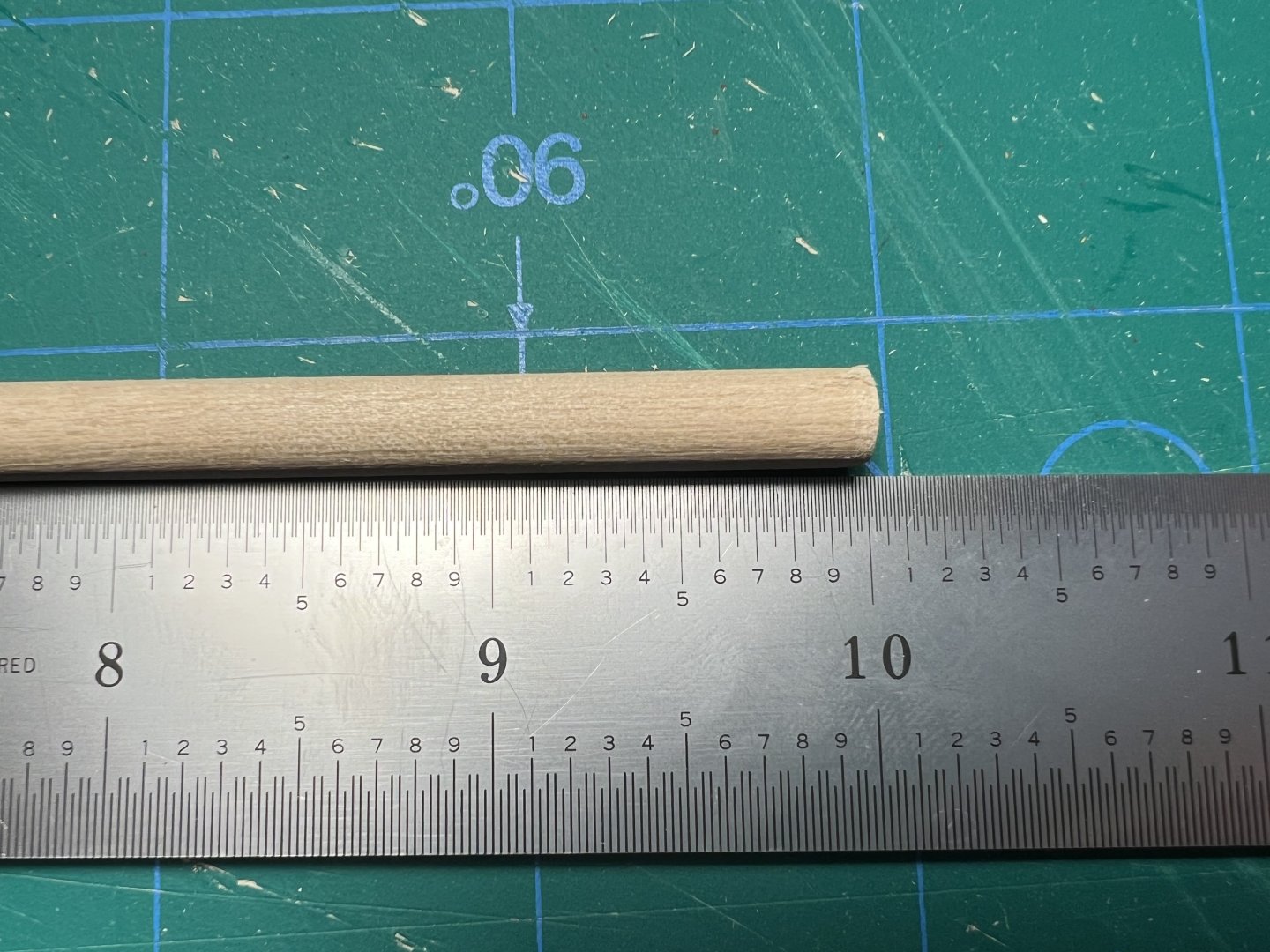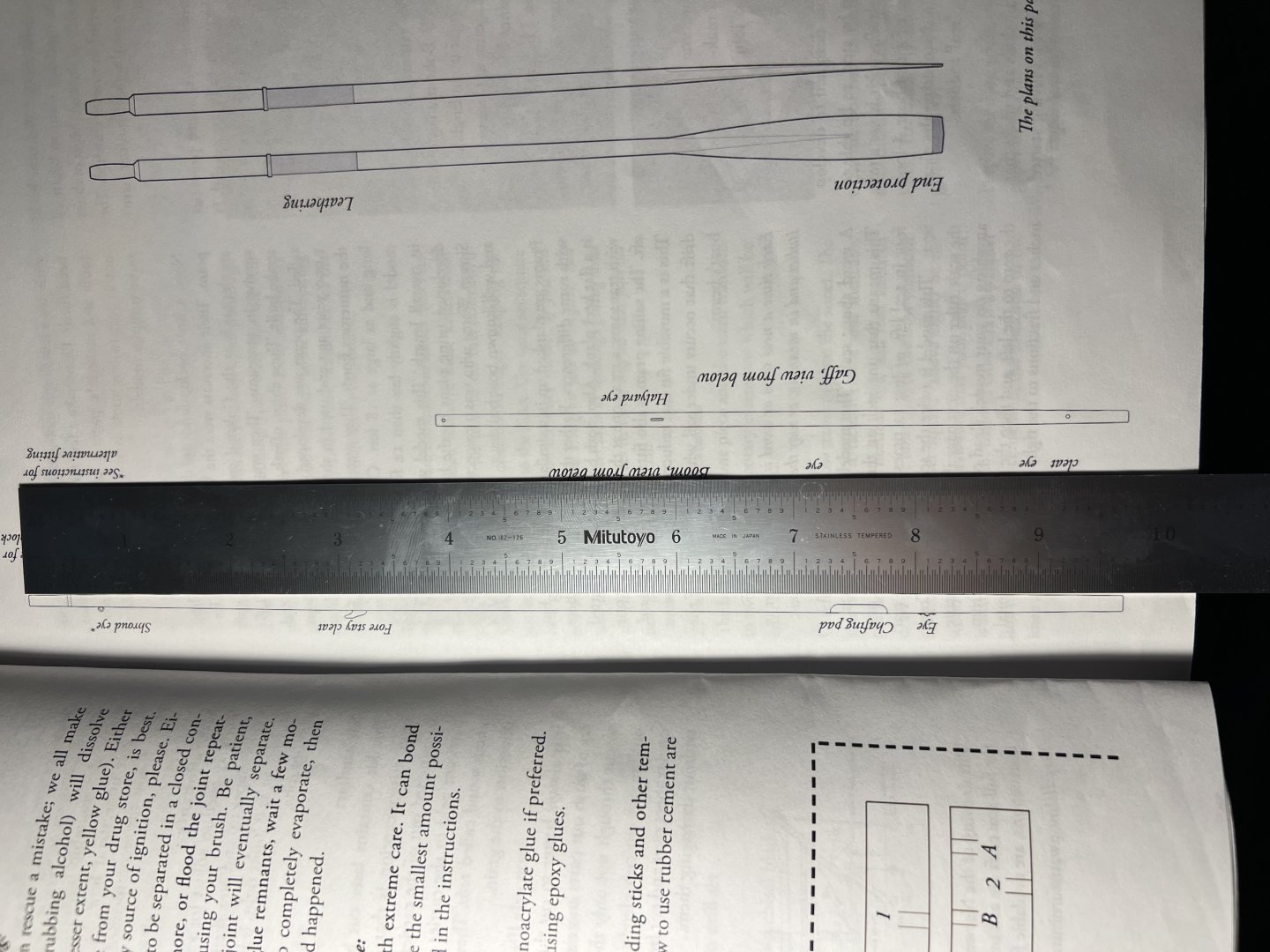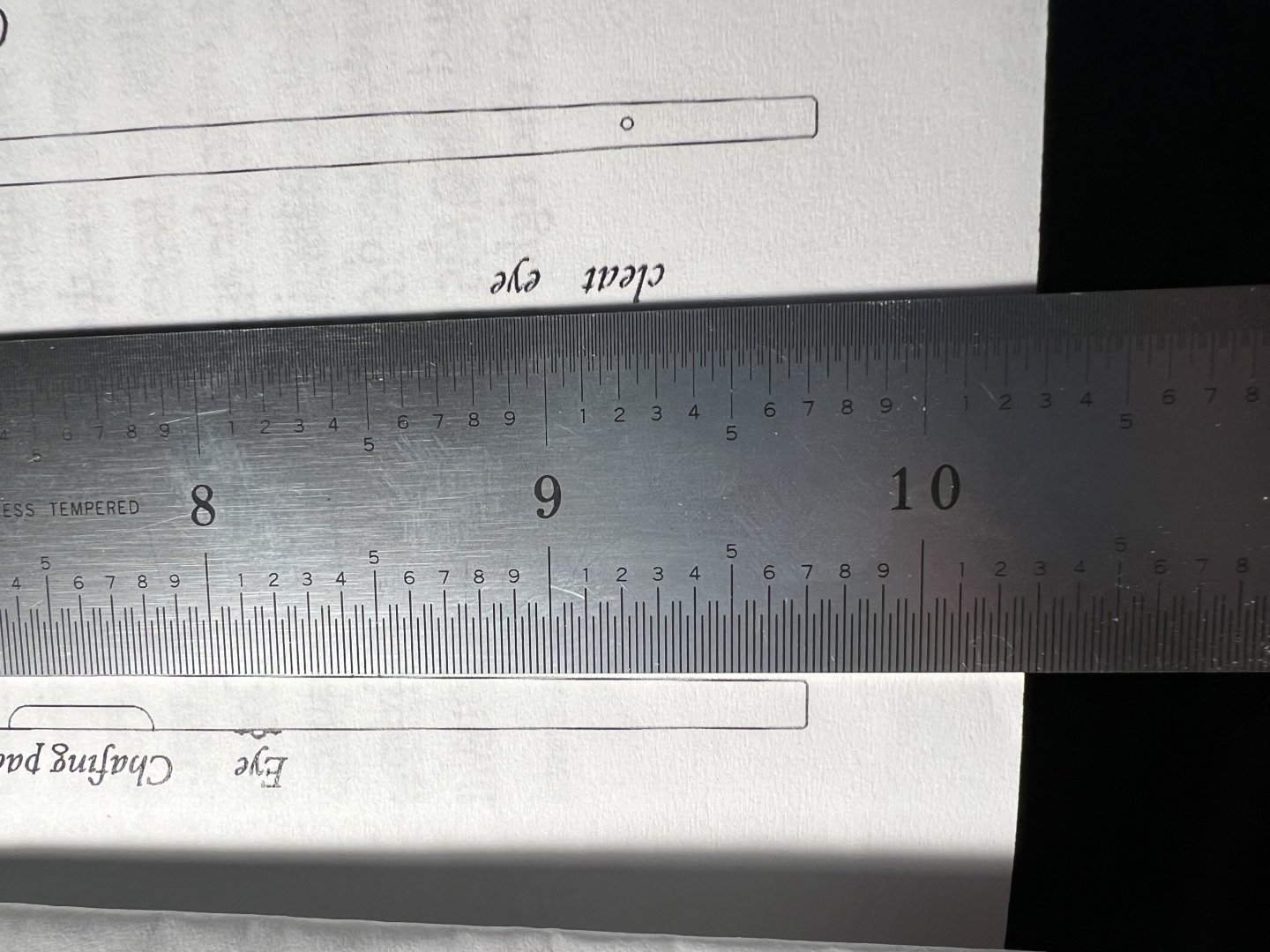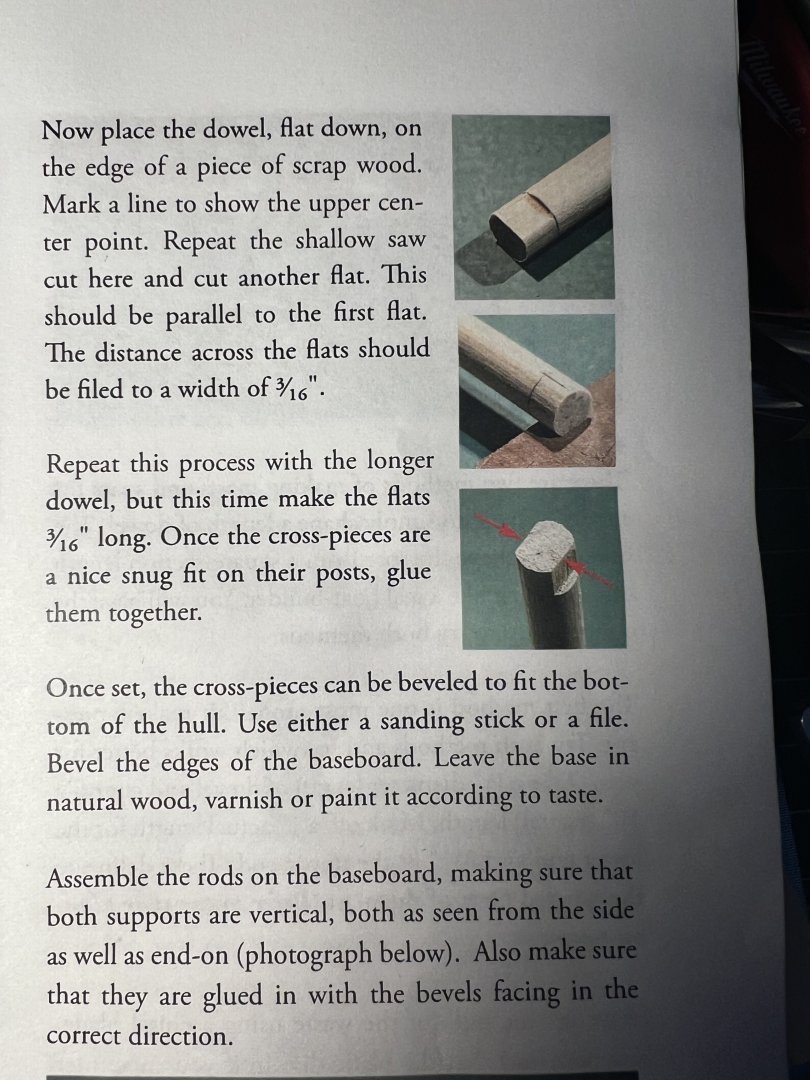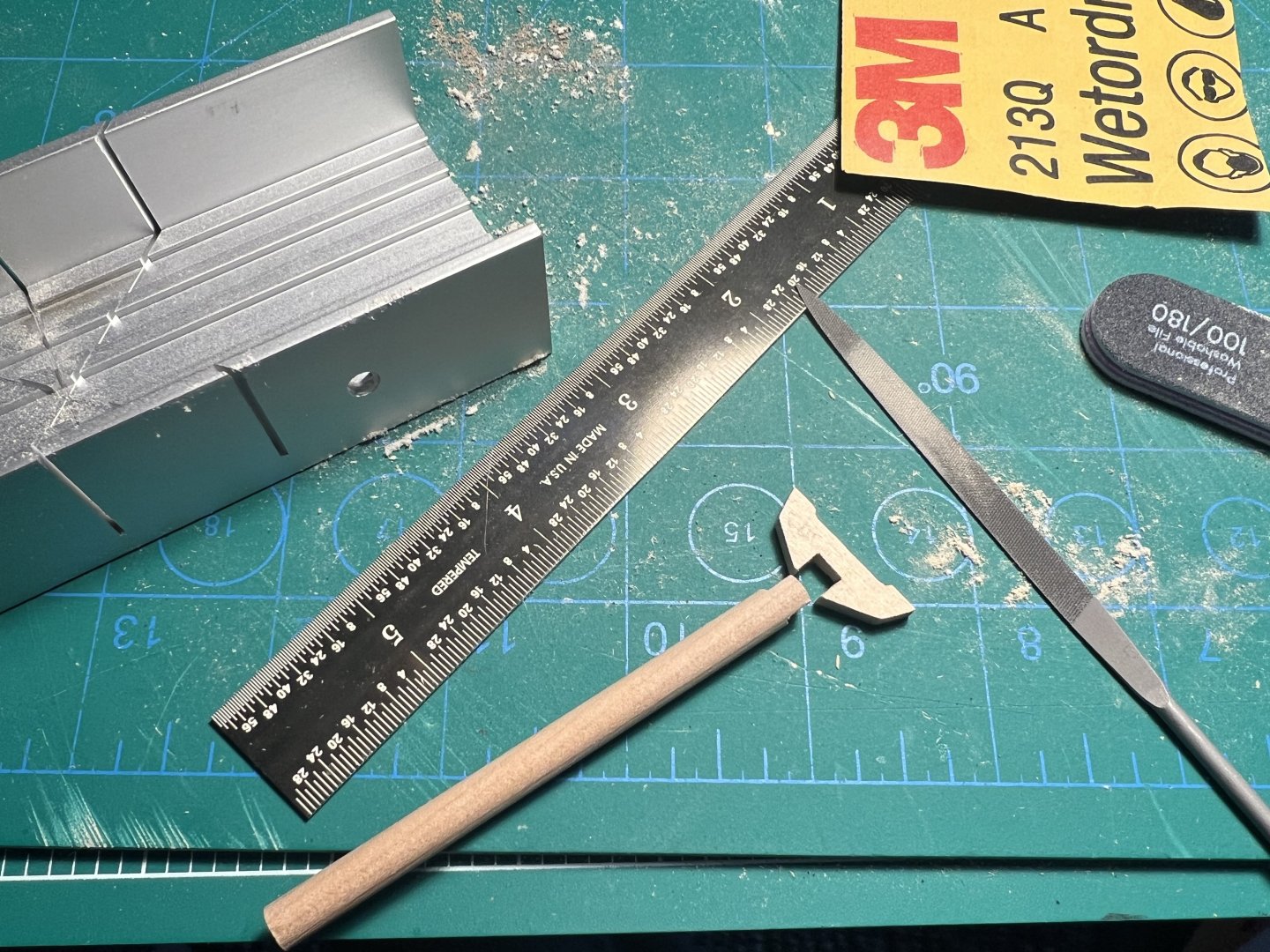
palmerit
NRG Member-
Posts
999 -
Joined
-
Last visited
Content Type
Profiles
Forums
Gallery
Events
Everything posted by palmerit
-
- 177 replies
-
- Sherbourne
- vanguard models
-
(and 3 more)
Tagged with:
-
The main mast, mast caps, and main topmast are assembled (glue is drying). Thankfully I attended to how the holes that were drilled into the topmast needed to be oriented. Will paint black both mast caps and the masts areas between them.
- 177 replies
-
- Sherbourne
- vanguard models
-
(and 3 more)
Tagged with:
-
It looks according to the plans that there might be a narrow disc on top of the main topmast. Is that right? I didn’t see it on the photos in the manual (but I think some of the photos are from a different ship). If so, would those be left natural wood or painted black?
- 177 replies
-
- Sherbourne
- vanguard models
-
(and 3 more)
Tagged with:
-
To get everything to stay aligned with gluing, I made a copy of the section of the plans and taped it to a scrap piece of board (the build board from my Dory), inserted the glued mast cap to the mast, and taped everything down in position relative to the plans. We’ll see how this works.
- 177 replies
-
- Sherbourne
- vanguard models
-
(and 3 more)
Tagged with:
-
I ran a round file a little bit on the inside of one of the pre-drilled holes in the mast cap (did a little, checked, did a little more) and that was enough to get the slight angle.
- 177 replies
-
- Sherbourne
- vanguard models
-
(and 3 more)
Tagged with:
-
- 177 replies
-
- Sherbourne
- vanguard models
-
(and 3 more)
Tagged with:
-
Suggestion on how to get the mast caps to the right angle (84.49 degrees on the plans)? Right now, the top of the main mast is right at 4mm, and the mast caps ride snugly. I’m guessing I either need to narrow the mast a bit more or widen the mast cap hole a bit. That’ll make it loose and allow it to take on a slight angle but then it’ll be loose. Do I then just “lather” with glue and hold it in place until it’s set? That’s what I’ll plan to do tomorrow unless someone has a better suggestion.
- 177 replies
-
- Sherbourne
- vanguard models
-
(and 3 more)
Tagged with:
-
Starting to plank the Smack. One nice thing about working on multiple models at once is that I don’t need to rush anything. The garboard is glued on after having been shaped. Now the first strake is being shaped after soaking for a bit in hot water.
- 59 replies
-
- muscongus bay lobster smack
- Model Shipways
- (and 2 more)
-
I saw that but I wasn’t sure if that worked for all the blocks. Thanks!
- 177 replies
-
- Sherbourne
- vanguard models
-
(and 3 more)
Tagged with:
-
I think I’ve hit the first point where the instructions leave me a bit befuddled. I’m at the point of shaping the masts and spars, which I think I know how to do. I’m not entirely sure the best way to tie the blocks onto the masts and spars. I see where to tie them on the plans. I’m not sure how - what kind of knot to use etc. If someone can point me to a good tutorial it’s be appreciated.
- 177 replies
-
- Sherbourne
- vanguard models
-
(and 3 more)
Tagged with:
-
I added the deck, faired the hull, and started to add the keel. I’m not entirely sure how much to fair the part near the stern. I’ll need to check the fit of the planks. I had to sand down some of the bulkheads quite a bit in a few places because they extended too far beyond the deck.
- 59 replies
-
- muscongus bay lobster smack
- Model Shipways
- (and 2 more)
-
I did finally finish the anchors. The black straps are made from thin strips of thick black paper that you cut from a small supplied sheet. I started by glueing the strips to the bottom of the cross piece a letting them dry (I intended overnight but it was actually for a few days). Then I glued one strip to one side, let that dry for a few minutes, then glued the next strip to to one side and let that dry, and so on. Then I went back to the first strip and glued to the next side and let that dry, and so on. I kept the strips far too long, in part because I wasn’t sure if I should wrap once or twice. I ended up wrapping just once around. I cut the excess when I got all the way around.
- 177 replies
-
- Sherbourne
- vanguard models
-
(and 3 more)
Tagged with:
-
I previously posted that Lego was releasing its own version of the Endurance: I told my wife about it and she actually put it on my Christmas list. That was a nice surprise under the tree. It's been a while since I've had to help my boys build their Legos, though my job was usually finding parts for them. My boys also bought me a Model Shipways Syren. Another nice surprise. I think now I have about five years of models to build. My wife told me this morning that she tried ordering it from Lego on the day it was released but it quickly sold out online. It was sold out at one of the Lego stores in Nashville but she saw that there were some at the other Lego store. They wouldn't hold it for her. She said she went to that Lego store on Cyber Monday (and she never goes to the mall) after we returned from visiting family over Thanksgiving. There was a line out the door and they were only letting someone in after someone left. She saw two Endurance models remaining on the table near the front door. While waiting in line, one couple in the store was eyeing one up, another almost grabbed one, and the people behind her said they were planning to grab one if they could get inside. She was able to get one of the last two before they sold out. Over the Black Friday week the Endurance came with a free gift of the Shackleton Lifeboat at a larger scale. I hope it's okay to do a build log on a Lego set. I'm guessing I'm not going to run into problems with misaligned parts, poor instructions, and broken masts. And there should be far less sanding. And it'll probably take me 2% of the time it takes to do a simple wooden ship model. It's a nice thing to build while watching some football or movies with the family in the living room. It's Christmas Day, so it's two football games today on Netflix and maybe a movie tonight.
-
I haven't yet begun the rigging on my Sherbourne, in part because I've been trying to read build logs for tips and recommendations. I'm planning to post some of those here (for my reference, for others to check out). I'll update this post as I find more. Here's one on the NRG Rigging Project build that illustrates shrouds, ratlines, deadeyes:
- 177 replies
-
- Sherbourne
- vanguard models
-
(and 3 more)
Tagged with:
-
I'm thankful that the first kit I bought was the Vanguard Sherbourne (a decision I made after reading a lot of posts here). The instructions are very clear, the pieces fit together really well, the parts are clearly labeled, the materials are high quality. It's kind of unfair that a complete novice can make a model that looks so good. (I have Syren on my list for a more advanced build someday after I clear the stash I've accumulated.) I've also been building the Model Shipways Shipwright series of boats (Dory, Pram, Smack). The instructions are detailed, but not always entirely clear. You'll see in some logs (not just mine) things like "I had to puzzle over ..." or "I had to read ahead ..." to figure out what to do. It's sometimes like solving a puzzle to figure out what the next step is. Once you figure things out it makes sense. Part of the challenge is that the instructions often describe the way to do something but the parts don't make it obvious which of a few ways to do something, the photos are fuzzy and not often from the best angle, let alone multiple angles. The plans in the instructions are inexplicably not to scale sometimes, and you often need to use the plans to build a part. Not all the pieces are clearly labeled. And what's in the instructions sometimes doesn't match the materials supplied. And much of the wood is basswood. It's not the case that pieces fit together, but that you need to align them right and glue them in place, sometimes hoping that you get them just right because a future step is going to rely on getting their placement just right, and neither the instructions nor the build make that obvious. My sense is that's not unique to these models but is fairly common to the design of lots of "old school" wooden ship models. I know this can read an indictment, and it's not intended to be, but as a heads up to the novice to expect more of a challenge than the "best for novice" designation or recommendation might seem to indicate. I've posted basically the same other places before. I'm posting here again for when future novices might stumble upon this thread looking for a "best" model recommendation. I'd recommend a novice either getting the Vanguard Sherbourne or one of the Vanguard fishing vessels rated as Novice. Then either continue with Vanguard Models or try one of the novice models from Model Shipways, Midwest, or Bluejacket if you want to exercise some other wooden model ship muscles. The Vanguard Models are more expensive. The Vanguard Models will take more time to build that the Shipwright Series models, so it's probably a wash in terms of the "dollars per hour" part of the equation, let alone the quality of the final product. The biggest challenge of the Vanguard Sherbourne (and the same would be true for the Vanguard fishing boats) is going to be the hull planking (haven't got to rigging on it yet, and I'm sure that's also going to be a challenge). The planking on the Model Shipwright series is definitely simpler. But unfortunately, the way the Model Shipwright series does its planking (laser cut parts of different shapes) is completely different from the way the Vanguard model does its planking (wooden strips). I did learn a lot doing the NRG half hull, but that's also a completely different way from either of those (scratch built pieces from a basswood sheet).
-
Oops. I was rounding the boom and the gaff in my drill and was a little too aggressive. These start square, being from a laser cut thick sheet. There’s a couple of precut holes, which in a nice gesture, but it also makes the wood really weak around the hole. Model Expo has a parts request page to order a replacement part (https://modelexpo-online.com/parts). In addition to ordering a new sheet with the boom and gaff, I also asked for another PE sheet because there weren’t enough long pieces for the pintles.
- 63 replies
-
- Norwegian Sailing Pram
- Model Shipways
-
(and 2 more)
Tagged with:
-
As someone who's brand new to this kind of modeling (just started over the summer) - and as someone who has used the forum to answer the question of what the "best" kit is (for a beginner) and who asked a "best second kit" question - when someone is a novice, or even has one or two kits under their belt, it is hard to even know what "with respect to what" factors to ask about or to specify. I wouldn't have known, for example, how different models can be in terms of the quality of their materials and the way they fit together and how different they can be in the clarity of the instructions until I worked on a couple of kits. If someone's a beginner, or has done one or two kits, they probably don't really know what the criteria are. Even reading build logs, you often don't understand what the differences are until you get your hands on a model. (It is odd to hear that some manufacturers still send instructions by CD/DVD. I haven't had a computer with a CD/DVD drive in a decade.)
-
Completed the mast. Thankfully had NFL Redzone to watch while sanding. Glad I had my air mask for this sanding using my drill. Also finished the stand.
- 63 replies
-
- Norwegian Sailing Pram
- Model Shipways
-
(and 2 more)
Tagged with:
-
I used the drill method to shape the mast. I wrapped the end in several loops of paper to avoid getting chuck marks on the end of the mast. And I used a clamp to keep the drill running.
- 63 replies
-
- Norwegian Sailing Pram
- Model Shipways
-
(and 2 more)
Tagged with:
-
The instructions acknowledge how much the dowel needs to be reduced in size. And notes how long it took the kit designer to do it. The question is still why? A 3/16” dowel could have been supplied instead. Maybe it was the economics and 1/4” dowels are way less expensive. Or maybe Model Shipways bought a literal ton of 1/4” dowels and supplies with kits with them whenever possible? Or is there another reason to supply a dowel so much larger than it needs to be?
- 63 replies
-
- Norwegian Sailing Pram
- Model Shipways
-
(and 2 more)
Tagged with:
-
The dowel supplied with the kit is a good bit wider than what’s needed in the plans. Not sure why. The instructions even note that the dowel is 1/4” and the plans indicate it should be more like 5/32 at its widest. That’s a lot of sanding, scraping, or planing.
- 63 replies
-
- Norwegian Sailing Pram
- Model Shipways
-
(and 2 more)
Tagged with:
-
- 63 replies
-
- Norwegian Sailing Pram
- Model Shipways
-
(and 2 more)
Tagged with:
-
I’m guessing the plans are out of scale (they’re on a page in the instructions, not on a separate sheet). The mast is cut from a dowel to 10”, with marks at 1” from the lower end and 3 1/8” from the upper end for the start of the tapers. The mast in the plans in the instructions is less than 10”. I’m guessing I’ll need to zoom in my printer. I saw in my Dory build from other logs that the plans weren’t to an accurate scale. Maybe the same is true for the Pram instructions? I missed a note to that in other logs, but I just made a quick pass. Frustrating if so.
- 63 replies
-
- Norwegian Sailing Pram
- Model Shipways
-
(and 2 more)
Tagged with:
-
At the step to make the display stand (which is before adding the rudder onto the boat). I wasn’t quite sure how best to notch the rods to accept the cross pieces. I ended up sawing down just a tiny bit to the width of the notch on both sides (measuring the the top the height of the notch on the cross piece rather than follow the instruction because the instructions weren’t entirely clear after a couple readings. Then I filed a bit on both sides, checking if the cross piece fit, filing some more, checking again, until it fit snug. Then glued.
- 63 replies
-
- Norwegian Sailing Pram
- Model Shipways
-
(and 2 more)
Tagged with:
About us
Modelshipworld - Advancing Ship Modeling through Research
SSL Secured
Your security is important for us so this Website is SSL-Secured
NRG Mailing Address
Nautical Research Guild
237 South Lincoln Street
Westmont IL, 60559-1917
Model Ship World ® and the MSW logo are Registered Trademarks, and belong to the Nautical Research Guild (United States Patent and Trademark Office: No. 6,929,264 & No. 6,929,274, registered Dec. 20, 2022)
Helpful Links
About the NRG
If you enjoy building ship models that are historically accurate as well as beautiful, then The Nautical Research Guild (NRG) is just right for you.
The Guild is a non-profit educational organization whose mission is to “Advance Ship Modeling Through Research”. We provide support to our members in their efforts to raise the quality of their model ships.
The Nautical Research Guild has published our world-renowned quarterly magazine, The Nautical Research Journal, since 1955. The pages of the Journal are full of articles by accomplished ship modelers who show you how they create those exquisite details on their models, and by maritime historians who show you the correct details to build. The Journal is available in both print and digital editions. Go to the NRG web site (www.thenrg.org) to download a complimentary digital copy of the Journal. The NRG also publishes plan sets, books and compilations of back issues of the Journal and the former Ships in Scale and Model Ship Builder magazines.

